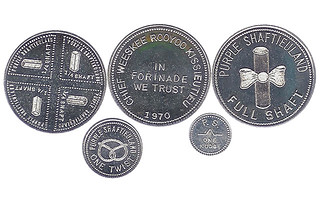
About UsThe Numismatic Bibliomania Society is a non-profit organization devoted to the study and enjoyment of numismatic literature. For more information please see our web site at coinbooks.org SubscriptionsThose wishing to become new E-Sylum subscribers (or wishing to Unsubscribe) can go to the following web page link MembershipThere is a membership application available on the web site Membership Application To join, print the application and return it with your check to the address printed on the application. Membership is only $20 to addresses in the U.S., $25 for First Class mail, and $30 elsewhere. For those without web access, write to: David M. Sundman, Treasurer
AsylumFor Asylum mailing address changes and other membership questions, contact David at this email address: dsundman@LittletonCoin.com SubmissionsTo submit items for publication in The E-Sylum, just Reply to this message, or write to the Editor at this address: whomren@gmail.com BUY THE BOOK BEFORE THE COIN |
- WAYNE'S WORDS: THE E-SYLUM NOVEMBER 16, 2014
- ASYLUM JULY-SEPTEMBER 2014 ISSUE PUBLISHED
- LAKE BOOKS SALE #120 CLOSES DECEMBER 16, 2014
- HOMREN OFFERS LITERATURE FIXED PRICE LIST #1
- NEW BOOK: AUTHORITATIVE REFERENCE ON LIBERTY SEATED HALF DIMES
- NEW BOOK: LAVERE REDFIELD: SILVER DOLLAR KING
- NEW BOOK: THE FIRST COLONIAL SOLDIERS
- BOOK REVIEW: FORGED IN PHILADELPHIA
- BOOK REVIEW: ENCYCLOPEDIA OF MEXICAN MONEY
- BOOK REVIEW: THE NUMISMATOURIST
- HARVEY STACK ON BOOKS AND THEIR VALUE, PART 3
- NOTES FROM E-SYLUM READERS: NOVEMBER 16, 2014
- MORE NUMISMATIC ITEMS DATED BY MONTH
- MORE ON KENT WHITING’S DAVIS FLIGHT MEDAL
- THE PLAIN EDGE 1907 WIRE RIM INDIAN EAGLE
- INTERVIEW WITH HOWARD M. BERLIN
- EXTRACTING A MEDAL EMBEDDED IN ACRYLIC
- 2015 CHURCHILL £5 COMMEMORATIVE COIN
- THE ROYAL MINT'S 2014 REMEMBRANCE DAY COIN
- CLASSICAL NUMISMATIC GROUP TRITON XVIII SALE
- ROSENBLUM OFFERS COLLECTION OF ISRAELI, PALESTINE, EGYPTIAN RARITIES
- COMMEMORATIVE MEDAL SELECTIONS FROM BALDWIN'S
- NUMMIS NOVA NUMISMATIC DIARY: NOVEMBER 16, 2014
- HOW TO MAKE YOUR OWN COINS, PART 2
- ISIS TO ISSUE ITS OWN COINAGE?
- QATARI COIN COLLECTOR SHEIKH AL-THANI DIED
- LIBERTY DOLLAR CREATOR TO BE SENTENCED
- RUSSIAN EBAY SELLER OF COIN COPIES
- 2015 COIN OF THE YEAR FIRST ROUND RESULTS
- AUSTRIAN BANKNOTE BRIBERY SCANDAL
- BEAUTIFULLY DEFACED ONE DOLLAR BILLS
- TOM'S TOOTH TOKENS
- FEATURED WEB SITE: ROWE-BARR TEXAS CURRENCY
Click here to access the complete archive
To comment or submit articles, reply to whomren@gmail.com
WAYNE'S WORDS: THE E-SYLUM NOVEMBER 16, 2014

New subscribers this week include: Hugh Williams and Tony Llaveria, courtesy of David Powell; Susan Trask courtesy of Dave Bowers; Gary Silvers, Kent Whiting, Graham Henry Neale and Brandon Adcock. Welcome aboard! We now have 1,792 subscribers.
We welcome Rosenblum Rare Coins as a new advertiser this week. We open with a new issue of our print journal The Asylum, a note from literature dealer Fred Lake, three new books and three reviews.
Other topics include the plain edge 1907 wire rim Indian Eagle, Numismatourist Howard Berlin, the Royal Mint's new coins, the upcoming CNG and Rosenblum auction sales, commemorative medals, planned new coins for ISIS, and the late Sheikh Saud bin Mohammed Al-Thani of Qatar.
To learn more about Silver Dollar King Lavere Redfield, the August 1, 1834 C. Bechtler $5 gold coin, the Tiberius Dupondius, the 2015 Coin of the Year voting results, embolismic coins, and Tom's tooth token, read on. Have a great week, everyone!
Wayne Homren
Editor, The E-Sylum
THE BOOK BAZARRE
ASYLUM JULY-SEPTEMBER 2014 ISSUE PUBLISHED
Editor David Yoon writes:
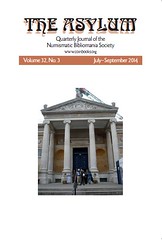 Another issue of
The Asylum is at the printers. Here are the contents:
Another issue of
The Asylum is at the printers. Here are the contents:
- Elizabeth Hahn Benge - From the Editor-in-Chief: Hello from the Windy City!
- Jeff Reichenberger - C. H. V. Sutherland: A Celebration
- Jeff Dickerson - Jim Halperin’s Floor Copies of Two Steve Ivy Sales
- David F. Fanning - Off the Shelf: A Modern Hardcover Rarity
- Joel J. Orosz - The 2014 NBS Symposium Joel J. Orosz
- Joel J. Orosz - The 2014 NBS Annual Meeting
For a membership form, see:
www.coinbooks.org/about/NBS_Membership_Form_2014.pdf
LAKE BOOKS SALE #120 CLOSES DECEMBER 16, 2014
Lake Books announces that its 120th mail-bid sale of numismatic literature is now available for viewing on their web site at http://www.lakebooks.com/current.html. The 474-lot sale contains select material from the library of William S. Panitch and has a closing date of Tuesday, December 16, 2014 at 5:00 PM (EST). Many scarce and desirable reference works appear in this sale including the 1985 “Numismatic Bibliography” written by Elvira Clain-Stefanelli, the complete four-volume set of Haxby’s “Obsolete Notes”, Kessler’s “The Fugio Cents” and a number of special editions of “The Redbook”. Your bids may be placed via email, US Mail, fax or telephone until the closing date.
Good Luck with your bidding, Fred
Lake Books
6822 22nd Ave N
St. Petersburg, FL 33710-3918
727-343-8055 fax:727-381-6822
HOMREN OFFERS LITERATURE FIXED PRICE LIST #1
NEW BOOK: AUTHORITATIVE REFERENCE ON LIBERTY SEATED HALF DIMES
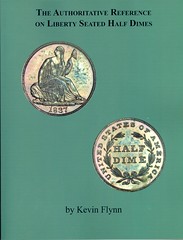 The Authoritative Reference on Liberty Seated Half Dimes book by Kevin Flynn is now available.
This book is being self-published, with only a limited number being printed. The book is 8 ½ by 11, 275 pages. Softcover $49.95 plus shipping.
The Authoritative Reference on Liberty Seated Half Dimes book by Kevin Flynn is now available.
This book is being self-published, with only a limited number being printed. The book is 8 ½ by 11, 275 pages. Softcover $49.95 plus shipping.
The primary purpose of this book was to create a complete and comprehensive reference for the Liberty Seated Half Dimes series including all die varieties, history, hub changes, archive letters, historical documents, and hot topics.
The die variety section of the book includes nine different 1838 doubled stars varieties and several between 1839 and 1840. Multiple photographs and complete diagnostics make distinguishing these varieties easy. Up to now, these were sometimes difficult to identify based upon the just written descriptions from previous references. One collector who reviewed this section, was able to go through eBay and identify all of these varieties.
There are eight different doubled dies and thirteen different misplaced dates, each with a full page full of macro photographs of all parts of the variety, full description, diagnostics, pricing, and comments. Also included are forty-three repunched dates. Several of these varieties have not been listed before. A complete analysis was done on all half-dime overdates. Several varieties that were previously listed as overdates were refuted. There are four valid overdates in the half-dime series. Overlays and macro photos were used to absolutely identify the underlying digits.
A complete analysis was done on the design changes made in the Liberty Seated half-dime series, and for some showing detailed photos of the differences. An analysis was also done on date and mint mark changes that occurred within a single year. An authentication section was included presenting diagnostics and detailed photos to help validate genuine specimens of rare coins.
The archive letters and the history section in the beginning of the book are primarily the same as presented in the book, The Authoritative Reference on Liberty Seated Dollars. A few new letters were uncovered and included. As these series were produced in parallel, it was decided to include all of the information for all of the Liberty Seated series for this time period to show what decisions and actions occurred concurrently. In addition, it is important that each book on each series is complete, and not require a different book for reference.
The Hot Topics section contains a several detailed studies on the Liberty Seated half-dime series including an analysis of: the stars used on the 1838 through 1840 half-dimes; the 1838 small stars, which includes 17 pages showing all die states; the 1838 corroded reverse; refuted overdates including the two from 1848 and the 1861/0 that is the result of a damaged date punch; 1840-O transitional reverse; 1859-1860 transitional obverse and reverse; 1870-S; early Liberty Seated proofs; early U.S. proof coin distribution, analysis of Liberty Seated certified proofs; and Liberty Seated proof counts.
Price for the softcover is $49.95. To order, send a check or money order to Kevin Flynn, P.O. Box 396, Lumberton, NJ 08048. Please include $5 for media shipping or $10 for first class shipping. Please email me at kevinjflynn88@yahoo.com to reserve a copy. See other books available at www.kevinjflynn.com.

NEW BOOK: LAVERE REDFIELD: SILVER DOLLAR KING
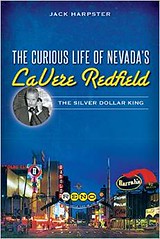 The Curious
Life of Nevada's Lavere Redfield: The Silver Dollar King
The Curious
Life of Nevada's Lavere Redfield: The Silver Dollar King
Paperback: 176 pages
Publisher: The History Press (November 4, 2014)
Language: English
ISBN-10: 1626197040
ISBN-13: 978-1626197046
Product Dimensions: 0.6 x 6 x 9 inches
LaVere Redfield was a prolific hoarder. When he died in 1974, his estate was estimated at more than $70 million. Executors found 680 bags of silver coins and 407,000 Morgan and Peace silver dollars in his Reno mansion. A local Reno legend, Redfield gambled regularly in Virginia Street casinos. He survived robbery and burglaries of his home, which contained false walls to store millions of silver dollars. Hating banks and paper money, as well as big government, Redfield opted to serve a prison term for income tax evasion rather than pay his debts from his ample fortune. Join author Jack Harpster for this first book-length study of this unconventional man behind the folklore and the myth.
Interpretations of the life of late Reno millionaire LaVere Redfield have often been more rumors than reality, more folklore than fact.
In the years since his death in 1974, it seems Redfield, who could often be seen about town in coveralls, plaid shirt and work boots, has morphed into a northern Nevada version of Howard Hughes — eccentric and paranoid, a recluse in the stone mansion he shared with his wife on Mt. Rose Street.
Jack Harpster, a retired newspaperman and author of seven other books in the biography genre, heard many of those Redfield stories after moving to Reno a decade ago.
"I heard a lot of myths and legends," Harpster said. "I thought he'd be an interesting guy to do some research on, so I started going through the old newspapers. It was a treasure trove."
What he found that LaVere Redfield was a complicated man and many of the stories were simply myths.
"Redfield had an awful lot of good qualities," Harpster said. "He was also a scoundrel in a lot of ways."
The newspaper coverage on Redfield — starting with a story about his being mugged on Forest Street by a brick-wielding robber who hit Redfield in the head multiple times — became the backbone of Harpster's latest biography, "The Curious Life of Nevada's LaVere Redfield: The Silver Dollar King," released this month from The History Press.
Harpster augmented his research with interviews of more than 20 people who knew Redfield personally or had close interaction with him.
To be sure, he said, Redfield was an interesting character: a keen investor in the stock market and real estate; anti-government (especially the IRS); a ruthless businessman; a man who didn't trust banks; a high-stakes gambler; a philanderer; a victim of at least two high-profile robberies; a man who hated to have his photo taken and a notorious hoarder.
At the time of his death, Redfield's estate was valued at more than $70 million and executors found hundreds of bags of silver coins stashed in the garage of his Reno mansion.
His largesse in gambling was opposite of his penny pinching in his business and personal dealings, Harpster found in his research. Redfield was involved in more than a dozen lawsuits and frequented city council and county commission meetings in an effort to get his property taxes reduced. Despite owning numerous vehicles, Redfield would walk from the mansion on Forest Street to downtown Reno to gamble because he didn't want to spend money on gas to drive there.
He preferred to wear overalls or a flannel shirt and jeans mainly because he didn't want to be recognized, Harpster said. He once pleaded with Reno Evening Gazette publisher Rollan Melton to keep the newspaper photographers from taking his photo, again, because he didn't want people to know what he looked like.
For many years, rumors have persisted that the more than 400,000 silver dollars found hidden in Redfield's garage and mansion after his death were only a part of his treasure, that more might be buried elsewhere.
Harpster isn't so sure.
"Personally, I don't believe so," he said, but then added. "If the house ever gets torn down, I hope they do it carefully."
To read the complete article, see:
The real story of Reno's 'Silver Dollar
King' (www.lasvegassun.com/news/2014/nov/12/the-real-story-of-renos-silver-dollar-king/)
NEW BOOK: THE FIRST COLONIAL SOLDIERS
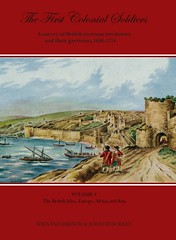

The First Colonial Soldiers: A survey of British overseas territories and their garrisons 1650 – 1714
Volume 1: The British Isles, Europe, Africa and Asia. With an introduction by Professor John Childs, this volume covers the Channel Islands, the Isle of Man, Dunkirk, Mardyck, Gibraltar, Minorca, Tangier, the West African settlements, St Helena and the Far Eastern outposts of the Honourable East India Company.
Volume 2: The Americas and the Caribbean. With an introduction by René Chartrand, his volume covers Nova Scotia, Newfoundland, Hudson’s Bay, all the colonies of New England, British Honduras, British Guiana, Amazonia, The Miskito Coast, the Bermudas, Jamaica, the Bahamas, the Barbadoes, the Windward and the Leeward Islands.
THE BOOKS
These two volumes provide a survey of the military effort of Britain in the colonies and overseas territories in their earliest years. Volume 1 covers Europe, Africa and Asia and also surveys the Channel Islands and Isle of Man. Volume 2 covers North, Central and South America and the Caribbean. Together, they bring much detailed information together on the military forces and garrisons of the empire, much of which is unpublished and has been gathered from original source material. The books provide full lists of the officers the regular and militia forces in the colonies and overseas territories, including biographical details; they also give details of the expeditions that seized the territories, including in Volume 2, the part played by the militia regiments of New England and the West Indies. They are a must for any student of early colonial forces.
Features:
- Descriptions of every territory, its origins, the military forces employed to seize it and its later military establishment
- Detailed lists of regular garrisons, companies, regiments, colonial/provincial regulars and the Ordnance Office detachments
- Detailed lists of the Militia regiments
- Descriptions and lists of expeditions mounted by colonial troops, especially those against Quebec, Hispaniola, Guadeloupe and Martinique
- Survey of the various Companies and their garrisons (Royal African, Newfoundland, East India, Guinea and so on)
- Surveys of the Channel Islands ands Isle of Man
- Modern maps
- Contemporary plans and illustrations
- Introductions by two of the foremost historians of the period.
Vol 1, 320pp, ISBN 978-90-81888-2-1, will be available in November 2014
Vol 2, 520pp, ISBN 978-90-81888-3-8, will be available in March 2015.
Both Volumes Published by Drenth Publishing, Eindhoven, Netherlands,
http://www.drenthpublishing.nl
The Authors
Dr Wienand Drenth has already published work on British regiments in 1699 and 1714; Lieutenant-General Jonathon Riley served in the British Army for
39 years and has published 15 books to date.
Cost:
Vol 1
UK, £16; Europe, €20; US and Canada, $26
Vol 2
UK, £24.50; Europe, €30; US and Canada, $40
Discounted Price for two volumes
UK, £32; Europe, €40; US and Canada, $52
Please add £0.50, or €0.60, or $0.75 per book for packaging.
Please enquire for delivery rates by post office or DHL: depending on order size, the cheapest method will be selected.
BOOK REVIEW: FORGED IN PHILADELPHIA
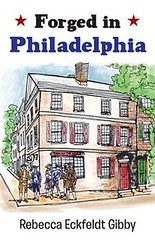 While
searching eBay a couple weeks ago to find a listing of the Eckfeldt Family Archives that was widely publicized as being offered there for sale, I
stumbled onto several other listings for a book titled Forged in Philadelphia by Rebecca Eckfeldt Gibby. Having missed the earlier
announcement of this book in The E-Sylum back in March, I was completely surprised and almost immediately ordered a copy of the hardcover
edition.
While
searching eBay a couple weeks ago to find a listing of the Eckfeldt Family Archives that was widely publicized as being offered there for sale, I
stumbled onto several other listings for a book titled Forged in Philadelphia by Rebecca Eckfeldt Gibby. Having missed the earlier
announcement of this book in The E-Sylum back in March, I was completely surprised and almost immediately ordered a copy of the hardcover
edition.
There was nothing within the description that would reveal the real nature of this book, but the fact that the author was an Eckfeldt herself made me believe that there may be some previously unseen documents, memorabilia or facts of interest. Upon actually receiving the book I was pretty disappointed to discover that it's actually a work of fiction loosely based on real characters. The inside of the dust jacket clearly describes the book as "Juvenile Fiction," and this should have been included in the eBay entry. The author is an educator of young children, and this is her first novel.
Using the real persons Jacob Eckfeldt, his son Adam, their family slave Christian and Martha Washington's maid Ona Judge, Gibby pieces together a story in which the U. S. Mint is simply a backdrop. There's nothing here for the numismatist, though the book might make a nice gift for a young person who has already shown some interest in the period or in early federal coinage. The text utilizes imagined dialogue and is written for an age group that I would estimate at 9-13 or so.
The sole illustration is a black-and-white reproduction of the familiar 1914 painting by John Ward Dunsmore titled "Inspecting the First Coinage." The author relates that the story of Martha Washington donating a silver tea service to make the first USA coins was told to her as a child, it having been handed down through the family. She then states that "Research led me to confirm the story of the production of '1500 half dismes' in 1793 [sic] and Adam's part in that historic act." Though not specifically saying so, she implies that the source of the silver has thus been confirmed, a point which most students of our early federal coinage will dispute.
The author provides a brief glossary of names, publications and institutions that is generally more informative than the narrative text, and this is a nice touch.
The book has a list price of $28.99, but I paid $18.18 (a Randall Hoard price?) plus $3.99 for shipping. This was the best price I could find on the hardcover, which comes with an attractive dust jacket, but a less expensive softcover edition is also available.
To read the earlier E-Sylum article, see:
NEW BOOK: FORGED IN PHILADELPHIA (www.coinbooks.org/esylum_v17n12a06.html)
BOOK REVIEW: ENCYCLOPEDIA OF MEXICAN MONEY
 Here's your Editor's mini-review of the first volume of the Whitman Encyclopedia of Mexican Money, by Don and Lois Bailey. This first
book in a planned four-volume Encyclopedia is an introductory overview and history of Mexican coinage and currency (although paper currency is
limited to just one short chapter).
Here's your Editor's mini-review of the first volume of the Whitman Encyclopedia of Mexican Money, by Don and Lois Bailey. This first
book in a planned four-volume Encyclopedia is an introductory overview and history of Mexican coinage and currency (although paper currency is
limited to just one short chapter).
As an introductory volume it succeeds in providing a sweeping view of Mexican numismatics from the Cob coinage of the 1500s through modern commemoratives and proof sets. In addition to coins, volume 1 includes Mexican primitive money, patterns, tokens, sets, orders and decorations and medals.
Don't look for pricing information, though - other than a guide to calculating bullion values, this volume is all about listings and descriptions, but not prices. Those quickly get outdated however, making this book a keeper for the numismatist's shelf. But the book does provide general rarity descriptions, noting whether selected pieces are rare, very rare or "unconfirmed".
It passes my usual back-of-the-book test, providing a nice seven-page index, bibliography and five-page Glossary of terms. There are over 1,000 images, many in color. The typeface was developed especially for this book, with nice printed representations of the various Mexican mint marks and legend letters.
Whitman Encyclopedia of Mexican Money, volume 1
By Don and Lois Bailey;
ISBN 0794834074
Hardcover, 6 x 9 inches, 496 pages, full color
Retail $39.95 U.S.
To read the earlier E-Sylum article, see:
NEW BOOK: ENCYCLOPEDIA OF MEXICAN MONEY (www.coinbooks.org/esylum_v17n39a02.html)
BOOK REVIEW: THE NUMISMATOURIST
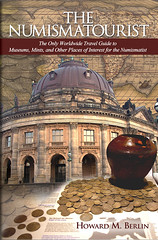 ‘Numismatourist’ is, of course, composed of the words numismatist and tourist
– this is the nickname once given to Howard M. Berlin by Wayne Homren, editor of the electronic newsletter E-Sylum. Since long Berlin has been
travelling through the world looking out for destinations linked to numismatics, particularly speaking of museums and exhibitions in central banks
and mints. The American taken by wanderlust wrote on these travels in a pluri-awarded column which appeared in WorldWide Coins. And,
eventually, Howard Berlin has gathered these experiences in a handy book available for a broad range of readers.
‘Numismatourist’ is, of course, composed of the words numismatist and tourist
– this is the nickname once given to Howard M. Berlin by Wayne Homren, editor of the electronic newsletter E-Sylum. Since long Berlin has been
travelling through the world looking out for destinations linked to numismatics, particularly speaking of museums and exhibitions in central banks
and mints. The American taken by wanderlust wrote on these travels in a pluri-awarded column which appeared in WorldWide Coins. And,
eventually, Howard Berlin has gathered these experiences in a handy book available for a broad range of readers.
To make the facts clear right from the beginning: Howard Berlin has seen over 50 countries, collecting more than 75,000 air miles (per year!), and presents in his book 175 places in 75 countries.
To the benefit of the readers the book is neatly organised. When you read it, you can feel that the three passions of the author are coins, reading, and writing. His readers can consider themselves lucky because this combination does not seem to be very common or Berlin’s book would have been written long ago by someone else.
The places are geographically arranged in larger sections like ‘North America’ and ‘Western Europe’, and, in these sections, in countries and regions. Those who will travel out of there nearer area will appreciate having some maps at hand which show quickly where the museums discussed are located.
Berlin starts always with an introduction of the museum and its coin collection (in general with a photograph showing the building from outside to help identify it when approaching in real life), and gives then more detailed information on the exhibition and the material on display, also accompanied by photographs. Finally you get all these useful information as in a ‘common’ travel guide: operating hours, how to get there, contact details. It is very reasonable to omit admission fees: they change too quickly. Anyway, you are vividly encouraged to check all contact details and internet addresses, too, before a visit.
The choice of museums follows personal reasons and raises no claim to completeness – and this is just the book’s charm. You don’t need to be planning any travel to get yourself into a dreamy mood while flicking through the book: What coins do you imagine when you hear ‘Paramaribo’? What do you think may be on display in Ruwi or Rabat?
As Berlin himself puts it, not everywhere they can show impressive collections. How could that be, anyway? But even with coins of inferior grade you can tell stories not less intriguing than those told by the showpieces of the great coin cabinets – as long as your exhibition has been made carefully. And, of course, in the ‘Numismatourist’ you will find all important coin cabinets of the world, too!
Howard Berlin invites you to share with him all kind of feedback, hints and updated information via email.
Howard M. Berlin, The Numismatourist. The Only Worldwide Travel Guide to Museums, Mints, and Other Places of Interest for the Numismatist. Zyrus Press, Irvine (CA), 2014. 22.7 x 15.2cm, 410 p., illustration in colour. Paperback. ISBN: 978-1-933990-29-3. Price: $29.95.
To read the complete article, see:
The Numismatourist: the new reference book for coin enthusiasts who love travelling
(www.coinsweekly.com/en/News/4?&id=3120)

HARVEY STACK ON BOOKS AND THEIR VALUE, PART 3
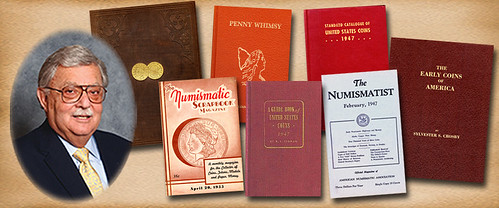
Today books are more expensive and they do not sell as well as the lower priced ones did years ago. Today’s “coffee table” volumes contain great information and wonderful color pictures but often cost $20 to $50 each or more. Sometimes the cost of the book may exceed the amount a collector would pay for an actual coin or note, and beginners especially find the higher prices prohibitive. Perhaps these hardbound books could also be published with a paper binding or be available as a smaller pocket book.
I believe it is important that all coin stores should stock books on various subjects, including the history of coinage, advanced studies of dies and designs, and of course price listings so that new buyers and advanced collectors are informed about market values and costs. Stack's and the different companies owned by Dave Bowers published quarterly as well as monthly price lists offering coins for sale, as well as articles about various series. Also offered for sale were reference books from beginning to advanced. These publications were sent to in-house mailing lists compiled from customers, both auction and retail, and also to people who wrote in requesting information. This is how these companies grew their client bases. To attract readers, there were sections devoted to current conditions in the market place and historical stories to advance interest in numismatics.
Our way of merchandising not only coins but also knowledge expanded our business and helped our clients to build wonderful collections. I believe that this knowledge also led these collectors to better enjoy their hobby and their cabinets. Reading about coins and learning what others have accomplished in various areas is just another fascinating feature of numismatics. And, in the long run, our business benefitted as many of the collections we helped to build came back to us for sale by private treaty or at public auction. It is easy to see why I still endorse the policy of “Buy the Book Before the Coin.”
There are many books available today, some written a century or more ago and modified with new knowledge. There are also new books being written every year covering every field of numismatics. These can create a foundation of knowledge to guide collectors to greater appreciation of the hobby. Current books on dealers’ shelves, at bookstores, super markets, or libraries, or even in digital form can continue to develop interest in coins, be a source of increased learning, and may even be a store of value for the future.
So, I suggest anyone wishing to advance in numismatics, seek out the catalogs, books, magazines and other publications that enhance interest and knowledge.
Harvey adds:
Everyone says the internet is the thing of the future, but when one wants to learn, it , in my opinion, is better to have a book on ones lap or desk for easy referral and information.
If one wants to look up specific information, yes, the internet is a good tool to help find some information to review. But if one wants to learn they need a book in hand, along with the coin so that each item will speak to the reader and give him the background needed to pursue his endeavors.
I hope what I said comes true, the screen is great, but the real book is SUPER.
To read the complete article, see:
Books and
their Value to Collectors, Part 3 (www.stacksbowers.com/NewsMedia/Blogs/TabId/780/ArtMID/
2678/ArticleID/64845/Books-and-their-Value-to-Collectors-Part-3.aspx)
To read the earlier E-Sylum articles, see:
HARVEY STACK ON BOOKS AND THEIR VALUE (www.coinbooks.org/esylum_v17n45a06.html)
HARVEY STACK ON BOOKS AND THEIR VALUE, PART 2
(www.coinbooks.org/esylum_v17n46a11.html)
NOTES FROM E-SYLUM READERS: NOVEMBER 16, 2014
A Phanes Stater
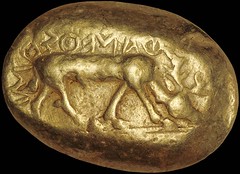

John Nebel writes:
I've been grazing in numismatic fields. Images of a Phanes stater, the first coin with an inscription, are attached. Ephesus late 7th century electrum. Literally, "Of Phanes I am". Who Phanes is, is not otherwise known.
A Note From ANS Librarian David Hill
David Hill, Francis D. Campbell Librarian of the American Numismatic Society writes:
 Thank you for the
post and for the kind words in the last E-Sylum. I'm looking forward to working with everyone on our shared interests. And keep up the
great work. As someone who struggles to come up with something just four times a year for our magazine, I don't know how you find so much of
interest to post every week!
Thank you for the
post and for the kind words in the last E-Sylum. I'm looking forward to working with everyone on our shared interests. And keep up the
great work. As someone who struggles to come up with something just four times a year for our magazine, I don't know how you find so much of
interest to post every week!
To read the earlier E-Sylum article, see:
ANS APPOINTS DAVID HILL AS LIBRARIAN (www.coinbooks.org/esylum_v17n46a06.html)
Correction: Confederate Half Article Author
To read the earlier E-Sylum article, see:
TWO ORIGINAL CONFEDERATE HALF DOLLARS COME TO MARKET
(www.coinbooks.org/esylum_v17n46a13.html)
Jeff Starck 's Article on Poe Medals
Jeff Starck of Coin World writes:
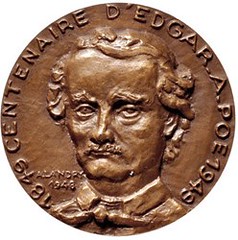 The subject of Edgar Allan Poe in numismatics is a fascinating one – I wrote an
article about the various medals honoring him, and include the Grolier and Landry pieces, as well as several others, concluding with the ANA’s 2008
medal for the World’s Fair Of Money in Baltimore.
The subject of Edgar Allan Poe in numismatics is a fascinating one – I wrote an
article about the various medals honoring him, and include the Grolier and Landry pieces, as well as several others, concluding with the ANA’s 2008
medal for the World’s Fair Of Money in Baltimore.
The article appears in the Dec. 21, 2009, issue. I’d be delighted to send a copy to anyone sending a SASE to me at Amos Media, P.O. Box 150, Sidney, OH 45365.
To read the earlier E-Sylum article, see:
MORE NUMISMATIC REMEMBRANCES OF EDGAR ALLAN POE
(www.coinbooks.org/esylum_v17n46a10.html)
MORE NUMISMATIC ITEMS DATED BY MONTH
C. Bechtler $5 August 1, 1834
Paul Horner writes:
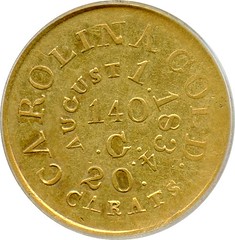 There
is at least one coin dated to the day: Some rare varieties of a C. Bechtler $5 have the date "August 1, 1834" on it.
There
is at least one coin dated to the day: Some rare varieties of a C. Bechtler $5 have the date "August 1, 1834" on it.
Christian Bechtler was a coiner in Rutherford, NC. The US Government had announced that new gold coins would bear the date "August 1, 1834" to distinguish new tenor coins from the old. Instead the government coined a new design and scrapped the oddball date idea. Christian Bechtler put the date on his new dies and used them for a time.
For more information on the Bechtler Mint, see:
Bechtler Mint (www.southerngoldsociety.org/bechtler-mint/)
Turkish 1 million Lira (KM 1139.1)
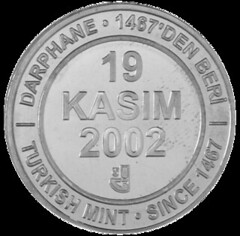
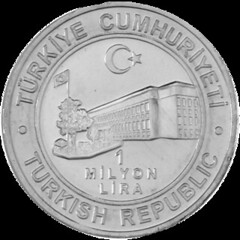
George Cuhaj writes:
This is an illustration of KM 1139.1 It was struck at a press at the Istanbul mint money museum. It has the date, month in Turkish, and year. It was used for 8 months in 2002.
There is a second variety used during the whole of 2003, where the reverse die has the date, month in both Turkish and English, and the year.
The denomination was 1 million Lira, in their old system which was replaced in 2005. 11.87g, Brass center in Copper-Nickel ring. 32.1mm
Jeff Starck of Coin World also thought of this coin. He writes:
Earlier this century, Turkey allowed visitors to the mint to strike coins with the date they visited. You can see this in an image posted at dealer Bob Reis’ website (www.anythinganywhere.com). He offers a ringed bimetallic 1 million lira coin. Clearly these were issued as commemoratives, aimed at visitors and meant to be souvenirs. But you can’t get much more specific than the actual day of striking!
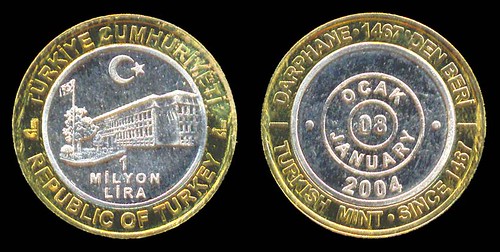
TURKEY, REPUBLIC, bimetallic 1 million lira K1139.2? 2004 January 08, Unc $8.50
Struck by a coin operated machine at the mint museum and bearing the date of issue. Supposedly there was a mintage of 500 maximum per day. Day dated coins have been made at other times and in other places, but the practice is rare. In 2005 Turkey dumped the inflated lira and issued a new one tied to the USA dollar.
To view the image on Bob's site, see:
www.anythinganywhere.com/commerce/coins/coinpics/tur-k1139'2-2004-1.jpg
Athenian Tetradrachms
David Powell writes:
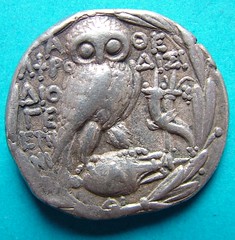 I should, of course, also have mentioned last week, when writing about
months on coins, the long series of Athenian Tetradrachms stretching over a century from very early in the 2nd cent BC to sometime in the first half
of the 1st cent BC. One of the defining feature of the series is that the reverse depicts the names of the city magistrates, flanking an owl, and a
letter of the Greek alphabet on an amphora below.
I should, of course, also have mentioned last week, when writing about
months on coins, the long series of Athenian Tetradrachms stretching over a century from very early in the 2nd cent BC to sometime in the first half
of the 1st cent BC. One of the defining feature of the series is that the reverse depicts the names of the city magistrates, flanking an owl, and a
letter of the Greek alphabet on an amphora below.
The sequence of the magistrates is known from other sources, although various scholars have argued over the base date from which the sequence starts. Margaret Thompson, in her "New Style Silver Coinage of Athens", which is regarded as the standard work, proposes a start date of 196 BC.
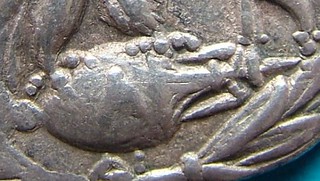 The letter on the amphora indicates the month within the year of office of
the magistrates stated; the position of the letter in the Greek alphabet indicates the number of the month in the year. On the example shown, the
letter is an alpha, hence month one of the magisterial year.
The letter on the amphora indicates the month within the year of office of
the magistrates stated; the position of the letter in the Greek alphabet indicates the number of the month in the year. On the example shown, the
letter is an alpha, hence month one of the magisterial year.
Greek months were lunar, and should therefore have been arranged along the lines stated last week; namely, twelve ordinary {12-month} and seven leap {13-month} years spread evenly over every nineteen years. Would-be magistrates no doubt coveted a leap year for their period of office, as it would give them another 29-30 days of power, and there are irregularities in the sequence of years containing intercalary coins {month 13} which imply that personal political ambition was occasionally allowed to take preference over the correct workings of the calendar; for example, by declaring a second leap year after one had just finished. This, if allowed to continue for even a very short time, rapidly throws the seasons out of sync.
The magic letter for one of these embolismic coins, indicating month 13, is N.
To read the earlier E-Sylum article, see:
NUMISMATIC ITEMS DATED BY MONTH (www.coinbooks.org/esylum_v17n46a29.html)

MORE ON KENT WHITING’S DAVIS FLIGHT MEDAL

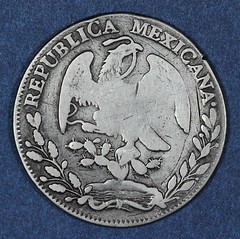
Peter Bertram on Kent Whiting’s Davis Flight Medal
It was nice to see two excellent pieces on Confederate items in last week's E-Sylum. I very much enjoyed the article reporting the upcoming auctions in 2015 of two of the four known Confederate Half Dollars – the first by Heritage in January and the other by Stack’s Bowers in March. I shall look forward to following these two next year.
These comments are, however, directed toward the second item - Mr. Kent Whiting’s Davis Flight Medal. It is always rather exciting when another of these little treasures turns up, each one adding something to our collective knowledge of the whole. I coined the term “Davis Flight Medals” to describe these engraved coins from the very end of the War Between the States. They all came from the Confederate Treasury as it left Richmond to avoid capture and they are all are inescapably bound to the flight, pursuit and capture of President Jefferson Davis.
Mr. Whiting’s specimen is an 8 Reals coin from 1861, engraved on the obverse at top “FROM GENL. JOS. E. JOHNSTON” – and in center “MAY/THE 1/1865”. The reverse is not shown but hopefully Mr. Whiting will provide us with an image later on. I believe this coin is from the $38,000 in silver left behind in Greensboro, NC as the Treasury Train passed through. General Johnston would use these funds to pay his Army.
I’ve noted seven different locations and dates between April 3 and May 8th or 9th, 1865, where disbursements were made from the Confederate Treasury and coins thus paid out are each a potential Davis Flight Medal. Mr. Whiting’s coin is engraved May 1 - late for Army pay, but not too late! References tell us the Army was paid on April 28 (Friday). I’ve seen one coin dated April 25 (Tuesday), four dated April 26, and one dated April 27 – but none dated April 28.
In addition to their pay, the veterans would each need a parole from the Federal authorities and these weren’t printed until April 30 (Sunday) in Greensboro and sent to officers for distribution. The Confederate soldiers received these over May 1 and 2, and began leaving for the long walk home on May 3 (Wednesday).
I therefore conclude that Mr. Whiting’s coin is indeed from the Greensboro army pay funds and note that Gen’l Johnston’s name engraved thereon is additional confirmation of this. The General’s name does not connect with the circumstances of any of the later Davis Flight Medals. At May 1, this coin is also the latest pay date I’ve encountered - too bad we don’t know the Confederate soldier’s name! Thanks for sharing with us, Mr. Whiting.
This is also an excellent opportunity to address another feature of the Davis Flight Medals paid out to Confederate soldiers in or near Greensboro, NC. Some, but not all, of these coins are engraved “From General Johnston” – and a few follow that with “To” and the soldier’s name. I do not believe these were personally given by Gen'l Johnston! Now I suppose it’s ever so remotely possible that the General handed out a few of the coins but I believe it to be so improbable as to be hardly even worthy of mention (but - never say “never” - right?).
What we do know is that when the Treasury Train left the silver coins in Greensboro, President Davis had also left instructions for the money to be sent on to him in Charlotte. General Johnston, however, felt it was more appropriate to compensate the soldiers who hadn’t been paid in a very long time. Accordingly the coins ($37,679.96 to be precise) were distributed to Regimental officers who took the money back to their men where they were encamped and divided it up the best they could. Some 32,174 soldiers were thus paid an average of about $1.17, some a little more, others a little less. I believe the soldiers knew that General Johnston had appropriated the Treasury Department funds to pay them and that is the reason for the “From General Johnston” engravings on the coins in question.
Confederate Davis Flight Medal Engraving Styles
Alan V. Weinberg writes:
Kent Whiting's May 1 1865 engraved 8 reales medal is in a distinctly different engraving style from the several pieces in my collection, all of which appear to be by the same engraver's hand.. Lest readers wonder why such an engraving appears on a Mexican silver coin, the Confederate Treasury at the time of the War's end was almost exhausted and made up almost exclusively of silver Mexican 8 reales and a very few well-worn U.S. Seated Dollar coins. The Union paid off the surrendering Confederate rag tag soldiers from this treasury.
To read the earlier E-Sylum articles, see:
MORE ON ENGRAVED CONFEDERATE DAVIS FLIGHT MEDALS
(www.coinbooks.org/esylum_v17n15a21.html)
TWO ORIGINAL CONFEDERATE HALF DOLLARS COME TO MARKET
(www.coinbooks.org/esylum_v17n46a13.html)
HAND-ENGRAVED CONFEDERATE DAVIS FLIGHT MEDAL
(www.coinbooks.org/esylum_v17n46a15.html)
THE PLAIN EDGE 1907 WIRE RIM INDIAN EAGLE
During 33+ years as a full time professional numismatist, I have had the opportunity to examine and handle many of the most important rarities in the American series, including two Brasher doubloons, all five 1913 Liberty nickels, two 1894-S dimes, and four 1804 silver dollars. I have handled 80 of the 100 greatest U.S. coins according to the study published by Jeff Garrett and Ron Guth.
I had the pleasure of examining and researching a coin that I believe carries more numismatic and historical importance than any of those coins mentioned above, or any other coin that I have ever handled. It is the 1907 Wire Rim Indian eagle with a plain edge. Only two plain edge specimens were struck, and they were the first Indian eagles ever created, to fulfill the wish of a dying man.
Augustus Saint-Gaudens was near death in the middle of July 1907. Dies for the Indian eagles had already been created, but the collar containing 46 stars was not completed. For that reason, the two plain edge coins were minted, one was sent to President Theodore Roosevelt, and the other was sent to Saint-Gaudens. The sculptor passed away a couple weeks later on August 3.
Roger W. Burdette has traced the issue in his reference Renaissance of American Coinage 1905-1908 (Seneca Mill Press, LLC, 2006), and Michael F. Moran has also examined the issue in his 2008 reference Striking Change — The Great Collaboration of Theodore Roosevelt and Augustus Saint-Gaudens.
This single coin seems to be the only coin of his own design that Saint-Gaudens ever saw in person.
This plain edge 1907 Wire Rim Indian eagle was offered for sale as lot 3561 in the Platinum Night session of Heritage’s 2010 ANA auction in Boston.
To view the auction lot description, see:
1907
$10 Wire Rim, Plain Edge, Judd-1902
(http://coins.ha.com/itm/proof-indian-eagles/1907-10-wire-rim-plain-edge-judd-1902-formerly-judd-1774a-pollock-1996-r8-pr62-ngc/a/1143-3561.s)
To read the complete article, see:
The Most Important Coin I’ve Ever Handled
(www.coinweek.com/education/numismatic-history/important-coin-ive-ever-handled/)

INTERVIEW WITH HOWARD M. BERLIN
Hello Howard, its great to catch up with you in the midst of your travels, I know you just traveled from the Baltics, one of my favorite places – where you visited Lithuania & Estonia, was this visit in connection with your latest publication or just for pleasure..?
 A bit
of both. My maternal grandfather emigrated from a small town in Lithuania to the U.S. and both Lithuania and Estonia were countries that I hadn’t
been to, despite having now been to 56 countries. On the “business” side, I had written about both the Money Museum of the Bank of Lithuania in
Vilnius and the Bank of Estonia Museum in Tallinn based on information and pictures supplied by these museums. It was one thing to write about
something from never having been there, so I wanted to have the experience of seeing these museums and personally thank the individuals for their
invaluable assistance. As it turned out, contacts at these museums provided other local venues and names of individuals at museums also having
numismatic items on display. Visiting these provided information and pictures for hopefully a second volume of The Numismatourist book.
A bit
of both. My maternal grandfather emigrated from a small town in Lithuania to the U.S. and both Lithuania and Estonia were countries that I hadn’t
been to, despite having now been to 56 countries. On the “business” side, I had written about both the Money Museum of the Bank of Lithuania in
Vilnius and the Bank of Estonia Museum in Tallinn based on information and pictures supplied by these museums. It was one thing to write about
something from never having been there, so I wanted to have the experience of seeing these museums and personally thank the individuals for their
invaluable assistance. As it turned out, contacts at these museums provided other local venues and names of individuals at museums also having
numismatic items on display. Visiting these provided information and pictures for hopefully a second volume of The Numismatourist book.
Speaking of your latest publication The Numismatourist I have to tell you its one of the best books I’ve read recently, I couldn’t put it down as it blends three of my favorite subjects coins, banknotes, and travel. This has certainly been a real labor of love but how did you come up with this great concept of meshing the two in such a well-done publication..?
Thank you for your kind words, coming from who has also visited and written about museums. Originally in 2009, I had written a two-page bi-monthly column, “World Destinations,” in WorldWide Coins, a sister publication of the weekly Coin World newspaper here in the U.S. I wrote about various museums I had visited. The column was well received as I was fortunate to have won the “Best Column for World Commercial Numismatic Magazines” category for two consecutive years by the Numismatic Literary Guild before the magazine ceased publication after a three-year run.
Since I still had lots of unpublished material about museums I had visited, the idea occurred to me that this information, if done properly, could be an interesting and unique topic for a sort of travel book. Plus, there was nothing out there like it. Many of the hobbyists and dealers travel a bit, and what better way would be to visit a museum, mint, or central bank during their trip? As for me, I love to travel, write, and I used to have a significant collection of coins and banknotes which I competitively exhibited and won a fair amount of “Best of Show” prizes. This type of book just seemed a natural extension of some of my interests.
The book is dedicated to the memory of Dr. Richard Doty, who was the Senior Numismatic Curator at the Smithsonian Institute and who sadly passed away last year & is greatly missed, how important do you think it is for any country to maintain a national collection of coins and banknotes – what does it “say” about a country and how they record history…?
The answer is best represented by the introductory paragraph of my book’s preface. To quote: “I feel that a country’s history is perhaps best exhibited by the evolution of its money, which both represents an intrinsic component of its heritage and mirrors its socioeconomic history. Also, the national legal tender is considered one of the leading symbols of that country’s identity and autonomy. What better way to educate the public about its monetary heritage than that of showcasing its numismatic treasures in an exhibition in a museum, the nation’s central bank, or a mint?”
What’s your next topic or project – you seem to be someone who is unstoppable & doesn’t sit around for long – do you think there is a second edition of this wonderful book in the future..?
I’m not getting any younger and am a few steps slower than last year, so I wouldn’t say I am “unstoppable,” and I don’t have museum “bucket list.” However if the book is successful, I hope the publisher would be inclined to allow me to write a second volume. In the meanwhile I have two non-numismatic book projects in various stages of gathering information. One is a specialized travel/history book about Berlin, where I visit several times a year. Another one is about Jerusalem’s Via Dolorosa and the 14 Stations of the Cross.
Howard Berlin, author-extraordinaire and habitual numisma-tourist, thank you very much for your time today.
Michael, it was my pleasure.
 The Numismatourist: The Only Worldwide Travel Guide to Museums, Mints, and
Other Places of Interest for the Numismatist is available by visiting the book’s own website at: http://www.numismatourist.com/
The Numismatourist: The Only Worldwide Travel Guide to Museums, Mints, and
Other Places of Interest for the Numismatist is available by visiting the book’s own website at: http://www.numismatourist.com/
ISBN-10: 1933990295
ISBN-13: 978-1933990293
Paperback
410 pages
Zyrus Press – Irvine, California
To read the complete article, see:
Interview with “The Numismatourist” Howard M. Berlin
(news.coinupdate.com/interview-with-the-numismatourist-howard-berlin-4568/)
EXTRACTING A MEDAL EMBEDDED IN ACRYLIC
How I removed a medal embedded in acrylic.
 Recently I acquired a 1¼-inch bronze medal embedded in an acrylic disc 2½-inches in diameter by 1-inch thick. I had been looking for this medal for
ten years and it filled in the final space in a 12 medal set. I did not, however, want it to be the only medal in the set in a 2½-inch lump.
Recently I acquired a 1¼-inch bronze medal embedded in an acrylic disc 2½-inches in diameter by 1-inch thick. I had been looking for this medal for
ten years and it filled in the final space in a 12 medal set. I did not, however, want it to be the only medal in the set in a 2½-inch lump.
I consulted various sources and found Alan Weinberg's suggestion to freeze it and then hit it with a hammer. While the medal is rare it was not expensive at $6.51 on eBay. So I decided to give it a whack. As can be seen from the picture the medal was embedded off-center and slightly tilted inside the acrylic with a few air bubbles around it. I suspect this piece was a discard. The medal was struck in 1953 and is one of several Lucite encased medals I have from the 1050s.
First: I reduced the size of the acrylic disc. A neighbor with a band saw cut off the excess bulk leaving me with roughly a 2-inch square cube 1-inch thick with a rounded top.
Second: I popped the block into the family freezer. I allowed it to sit there for two weeks. I noticed over time the interior of the block slowly became slightly opaque. It not so much misted over as it misted within. Maybe this is a sign of the cold penetrating the plastic. I do not know but when the misting stopped after about 10 days, I started to look for a hammer.
Third: I got my 14-oz. hammer, put on safety glasses and took the cube outside to a flat rock by the side of the house. I stood it up vertically, hit it smartly and a big lump flew off leaving one side of the medal exposed but it was mostly still embedded. I hit it again. This time more plastic shattered with shards going everywhere. The medal was now ¾ of the way out of the plastic with a jagged lump remaining at the top of the medal. I laid it on its side, hit it again and the rest of the plastic was gone. I was not very precise with my hammer and the third strike was off point and added a small dent to the top of the medal and removed the loop. For me, even given the bit of damage I did to the medal, having it out of the plastic in one piece was a triumph.
Aftermath: There were some small bits of plastic still adhering to the devices and lettering on the medal but a 24-hour bath in acetone (nail polish remover) turned those bits into little soft globs that could just be rolled off with a finger or picked off with a fingernail. Much like the glue that holds a new credit card to the mailer they send it in. The bonus was that the acetone did not change the finish on the medal.
Having done this once, I am now sure I can do it in the future with much more precision and no damage at all to the medal. I just need to learn to keep my eyes open!.
To read the earlier E-Sylum articles, see:
EXTRACTING ENTOMBED PAPER MONEY (www.coinbooks.org/esylum_v09n04a23.html)
EXTRACTING COINS EMBEDDED IN LUCITE (www.coinbooks.org/esylum_v09n04a22.html)
MORE ON REMOVING COINS AND MEDALS FROM LUCITE (www.coinbooks.org/esylum_v11n25a16.html)
MORE ON COINS AND MEDALS EMBEDDED IN LUCITE
(www.coinbooks.org/esylum_v13n40a14.html)
THE BOOK BAZARRE
2015 CHURCHILL £5 COMMEMORATIVE COIN
The new coins for 2015 have been announced and are now available on royalmint.com. The biggest reveal in today’s announcement is that these 2015 UK coins will be the last coins to feature the fourth portrait of Her Majesty The Queen. Next year the definitive portrait of Her Majesty The Queen is to be updated for the first time since 1998.
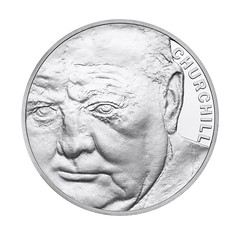 The 50th Anniversary of the Death of Sir Winston Churchill £5
The 50th Anniversary of the Death of Sir Winston Churchill £5
At the time of Sir Winston Churchill’s death in 1965 The Royal Mint issued a coin that became a classic, the essence of the man expertly captured by
Oscar Nenom. In 2015, a second coin will commemorate the 50th anniversary of the death of the great man, making him the only statesman ever to be
honoured on two UK coins. This £5 coin bears a portrait that fits with the artistry of Nenom’s design; created by Mark Richards FRBS, it conveys the
spirit of Winston Churchill as he was: larger than life.
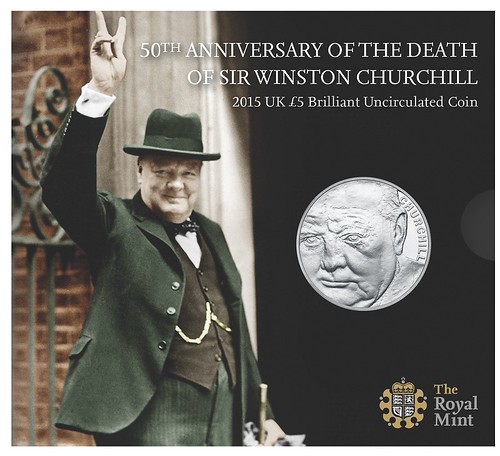
David Pickup adds:
Readers might ask whether the fiftieth anniversary of a death of even someone as significant as Churchill warrants the issue of a coin. The portrait on this coin is striking and the design is unusual. Although he photographed well it is difficult to convey his character on a coin. The original Churchill crown is probably one of the most unsuccessful (from a collector’s point of view) commemorative coins ever because of the vast numbers produced.
To read the complete article, see:
The 2015 UK coins announced (http://blog.royalmint.com/2015-uk-coins-announced/)
THE ROYAL MINT'S 2014 REMEMBRANCE DAY COIN
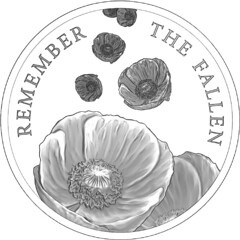 In the centenary year of the outbreak of the First World War, The Royal Mint has released a beautiful and touching 2014 Remembrance Day coin that
pays tribute to the brave service men and women who were lost in conflict. This year’s design builds on the iconic poppy image, with an evocative
‘falling poppies’ representation by Royal Mint Engraver, Laura Clancy. The design is also a further advance in The Royal Mint’s range of coloured
coins, following the release of the ‘Portrait of Britain‘ collection to which Laura also contributed.
In the centenary year of the outbreak of the First World War, The Royal Mint has released a beautiful and touching 2014 Remembrance Day coin that
pays tribute to the brave service men and women who were lost in conflict. This year’s design builds on the iconic poppy image, with an evocative
‘falling poppies’ representation by Royal Mint Engraver, Laura Clancy. The design is also a further advance in The Royal Mint’s range of coloured
coins, following the release of the ‘Portrait of Britain‘ collection to which Laura also contributed.
Laura’s Remembrance Day coin design is enhanced by the packaging, created by Royal Mint Designer, Dominique Evans, which builds on the falling poppies effect and the simplicity of the coin design.

In an interview with Laura we’ve gone ‘behind the design’ to get to know a little bit more about her and to find out more about the coin, the design and her inspiration.
Tell us a little bit about you…
I’m 36 and I’m from Cardiff. I studied for a 3D Arts degree at Brighton University, graduating in 2000. The degree involved woodwork, metalwork,
ceramics and plastics, but I specialised in metalwork and plastics. I began work at The Royal Mint six years later, in 2006, as a Trainee
Engraver/Designer. I saw the job, by chance, in the paper, and I thought ‘That is the job I’ve been looking for. That is perfect’. My training period
lasted 18 months, but I was given my first ‘live’ project after six. It was quite an exciting one – it was to model the winning design from a
children’s competition to design a medal for Her Majesty The Queen’s 80th birthday, which would be presented to her. I even delivered the medal to
Buckingham Palace!
How did you feel about designing such a symbolic coin?
Several years ago, I designed a 65mm coin, for the Solomon Islands, and the title I was given was Remembrance. My design showed a large poppy, with
an extract from the poem ’For the Fallen’ by Laurence Binyon, overlaid. I was fortunate enough to visit France and Belgium with The Royal Mint, as
part of the research, to visit war sights, memorials, graves, battlefields and museums. It was a truly inspirational trip. So, it was great to be
asked to do the 2014 Remembrance Day coin design because, having done the research before, I still had ideas from my previous poppy designs to
explore. I still have ideas now, so I’m hoping they ask me again in a few years! It was a good project to work on, there’s lots of resource and lots
to think about. I’d love to do it again.
Going to France and Belgium made a big difference to this project. Hearing ‘The Last Post‘, having looked around all the museums for two days – you’ve heard it before, you’ve done the two minute silence and you think about it – but suddenly you’re in the place and it all feels real. It’s very emotional, it brings tears to your eyes. There’s more meaning to it now than there would’ve been before I went.
It is such an emotive and moving subject. I tried to think of the different ways to portray it, such as the cenotaph or a wreath, but the red poppy has a such a strong association with remembrance – in a way, nothing else is needed. My job was to work with and add to that, hopefully in a sensitive, moving and artistic way.
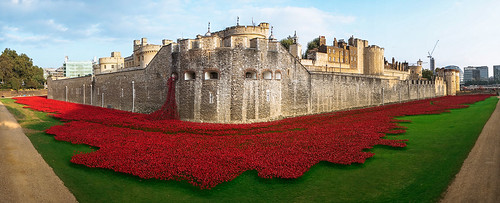
 A co-worker recently returned from a visit to London where she'd seen the installation of
ceramic red poppies at the Tower of London by artist Paul Cummins. Each of the 888,246 hand-made poppies represents a British and Commonwealth
soldier who died during WWI. It's a breathtakingly sad sight. -Editor
A co-worker recently returned from a visit to London where she'd seen the installation of
ceramic red poppies at the Tower of London by artist Paul Cummins. Each of the 888,246 hand-made poppies represents a British and Commonwealth
soldier who died during WWI. It's a breathtakingly sad sight. -EditorTo read the complete blog article, see:
Behind the design: Remembrance Day 2014
(blog.royalmint.com/behind-the-design-remembrance-day-2014/)
To read more about the poppy installation, see:
Tower of London poppies: Final poppy is 'planted'
(www.bbc.com/news/uk-england-london-30001177)

CLASSICAL NUMISMATIC GROUP TRITON XVIII SALE
Classical Numismatic Group of Lancaster, Pennsylvania and London, England is proud to present Triton XVIII, a Public, Internet, and Mail Bid Sale to be held in conjunction with the 43rd Annual New York International Numismatic Convention (NYINC) on January 6-7, 2015. The NYINC is held at the Waldorf-Astoria Hotel, located at 301 Park Avenue, New York, NY 10022, between 49th and 50th Streets. Triton XVIII will feature over 1900 lots of ancient Greek, Celtic, Oriental Greek, Central Asian, Roman Provincial, Roman Republican, and Roman Imperial coinage. Additionally, there are featured selections of Byzantine, Early Medieval, Islamic, World, and British Coinage. The pre-sale estimate total for Triton XVIII is $6.5 million and counting.
Triton XVIII will feature material from three different museums: The MoneyMuseum of Zurich, Switzerland–Selections from the Sunflower Foundation Collection–Greek, Roman Imperial, and Byzantine Coinage; The Royal Ontario Museum, Toronto, Canada–Roman Imperial Coinage; and The Colonial Williamsburg Foundation–Selections from the Joseph R. Lasser Collection–World and British Coinage, including an exceptional offering of fourteen deniers of Charlemagne, one of the largest offerings in a public auction in recent memory.
Additionally, items from over a dozen private collections will be featured in Triton XVIII, including:
- The Sunrise Collection–Numismatic Art of Persia–Greek and Oriental Greek Coinage;
- The RAJ Collection–Greek and Roman Republican Coinage;
- The Jonathan K. Kern Collection–Greek, Roman Imperial, Byzantine, and World Coinage;
- The Patrick H. James Collection–Greek and British Coinage;
- The Edoardo Levante Collection–Greek and Roman Provincial Coinage;
- Collection of a Southern Pathologist–Greek Coinage;
- The RH Collection–Greek Coinage;
- Selections from the RBW Collection of Roman Republican Coinage;
- The AK Collection of Trajan & Hadrian–Roman Provincial and Roman Imperial Coinage;
- The D. Fagan Collection–Roman Imperial Coinage;
- The RAM Collection of Roman Imperial Bronzes;
- Selections of World & British Coinage from the TJH Collection;
- Selections from the Michael Joffre Collection–Roman Imperial, World, and British Coinage;
- The Michael Joffre Collection of Anglo-Gallic Coinage; and
- Large Lots from the BCD Collection of Thessalian Bronzes
- Large Lots from the Archer M. Huntington Collection from the Hispanic Society of America
A few of the individual highlights from Triton XVIII are:
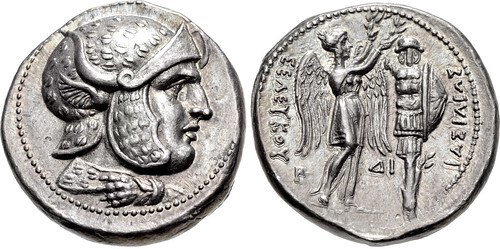
Lot 129. SELEUKID KINGS of SYRIA. Seleukos I Nikator. 312-281 BC. AR Tetradrachm (26mm, 17.07 g, 2h). Susa mint. Struck circa 305/4-295 BC. Head of hero (Alexander or Seleukos?) right, wearing helmet covered with panther skin and adorned with the ear and horns of a bull / BASI?EOS SE?EYKOY, Nike standing right, holding in both hands a wreath that she places on trophy to right; EP monogram to lower left, ?I in lower middle field. SC 173.11; ESMS Tr.54 (A40/P6); ESM 413; HGC 9, 20; Sunrise 174 corr. (monogram; this coin). EF, toned, great metal. Among the finest. Estimated at $75,000
From the Sunrise Collection.
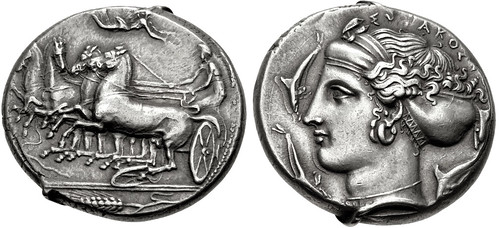
Lot 385. SICILY, Syracuse. Second Democracy. 466-405 BC. AR Tetradrachm (27mm, 17.23 g, 5h). Struck circa 413-405 BC. Charioteer, holding kentron in right hand and reins in both, driving fast quadriga left over wheel; above, Nike flying right, crowning charioteer with wreath held in both hands; in exergue, grain ear left / Diademed head of Arethousa left, hair in ampyx and sphendone with zig-zag lower border, wearing double hoop earring and necklace with pendants; SY[P]AKOSI[O-N] above, four dolphins around. Tudeer 69 (dies 25/47); HGC 2, 1342 (same dies as illustration); Basel 471 (this coin); BMC 220 (same dies); Boston MFA 415 = Warren 387 (same dies); Giacosa pl. 34 (this coin illustrated [obverse]); Gillet 637 (same dies); Gulbenkian 288 (same dies); de Luynes 1212 (same dies); Rizzo pl. XLII, 17 (same obv. die). EF, toned, minor double strike on reverse. A masterwork of Sicilian numismatics. Estimated at $30,000
From the collection of the MoneyMuseum, Zurich. Ex Athos D. Moretti Collection (Numismatica Ars Classica 13, 8 October 1998), lot 471.
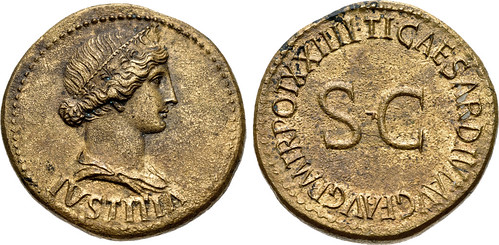
Lot 1008. Tiberius. AD 14-37. Æ Dupondius (29mm, 14.75 g, 12h). Rome mint. Struck AD 22-23. IVSTITIA below, draped bust of Justitia right, wearing stephane ornamented with floral ornaments; her hair fastened in a knot at the back / TI • CAESAR DIVI AVG F AVG P M TR POT XXIIII • large S • C. RIC I 46 (Tiberius); BMCRE 79-80 (Tiberius); BN 57-61 (Tiberius); AdG p. 39 (this coin). EF, lovely Tiber patina, minor surface roughness, traces of deposits. Fine style portrait. Estimated at $10,000
From the collection of the MoneyMuseum, Zurich. Ex Numismatica Ars Classica 15 (18 May 1999), lot 279.
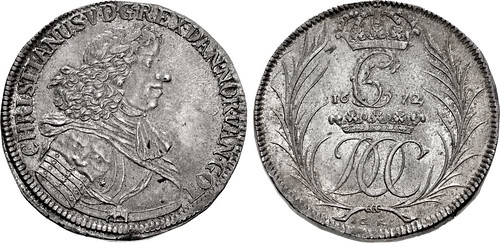
Lot 1502. DENMARK. Christian V. 1670-1699. AR Speciedaler (42mm, 29.02 g, 12h). Dansk Østindisk Kompagni (Danish East India Company) issue. Dated 1672. CHRISTIANUS • V • D • G • REX • DAN • NOR • VAN • GOT •, laureate, draped, and armored bust right / Crowned C5 monogram above crowned DOC monogram; 16 72 across field; all within palm wreath; G K below wreath tie. Edge: plain. Schou 7; Hede 63C; Jensen –; Davenport 410. EF, toned. Estimated at $10,000
From the Joseph R Lasser Collection for the benefit of The Colonial Williamsburg Foundation, purchased from James F. Elmen, 25 August 1986. Ex Zander H. Klawans Collection.
Lot viewing for Triton XVIII will begin on Sunday, January 4th, from 1PM until 7PM in the Carnegie Suite, located on the 18th floor of The
Waldorf-Astoria Hotel. The complete lot-viewing schedule for Triton XVIII is:
Sunday, January 4, 2015 – 1PM until 7PM;
Monday, January 5, 2015 – 9AM until 7PM;
Tuesday, January 6, 2015 – 8AM until 6PM; and
Wednesday, January 7, 2015 – 8AM until Noon.
Auction lots will also be available for viewing at the Pennsylvania offices of CNG from Monday, December 1st, 2014 until Wednesday, December 31st, 2014 by appointment only, with the exception of Friday and Saturday, December 12-13, 2014, when the lots will be on exhibit at the San Francisco Historical Bourse (SFHB). The SFHB is held at the Holiday Inn Golden Gateway, Van Ness and California Streets, San Francisco, CA from 10AM until 6PM each day. Please note that CNG’s office hours will be limited during the holiday season.
The auction sessions for Triton XVIII will be held in the Norse Suite, also located on the 18th floor of The Waldorf-Astoria Hotel. Triton XVIII will be conducted over four sessions with the morning sessions beginning promptly at 9:00 AM on Tuesday, January 6th, and Wednesday, January 7th, 2015, and the afternoon sessions will start at 2 PM on the same days.
In addition, there will be an online, Internet-only, Session 5 for Triton XVIII, which CNG will be conducting as our Electronic Auction 342, and will run online concurrently. E-Sale 342 will feature over 1,000 lots, including further selections from many of the same collections offered in Triton XVIII, and will close on Wednesday, January 14, 2015.
Printed catalogs for Triton XVIII will be available after December 1, 2014. To order a catalog, please visit www.cngcoins.com. Catalogs are $50 to North American addresses, and $75 to the rest of the world. Payment may be made by U.S. $ check or Visa/MasterCard. Catalogues will be mailed to customers on CNG’s active mailing list.
CNG is currently accepting consignments for its next mail bid auction, CNG 99, scheduled for May 13, 2015. The consignment deadline is Friday, January 16, 2015.
For further details and any additional information, please contact CNG, Inc. at:
Classical Numismatic Group, Inc. P.O. Box 479 Lancaster, PA 17608-0479 Telephone: (717) 390-9194 Fax: (717) 390-9978 Email: cng@cngcoins.com
About the NYINC:
The New York International Numismatic Convention is the United States’ most prestigious numismatic event targeting the needs of the world and ancient
numismatic communities. The 43rd Annual NYINC will be held at the fabled Waldorf-Astoria Hotel, located at 301 Park Avenue, New York, NY 10022,
between 49th and 50th Streets. The dates for the 2015 NYINC are Saturday January 3, 2015 through Sunday January 11, 2015, with bourse activities
taking place Thursday-Sunday, January 8-11, 2015.
ROSENBLUM OFFERS COLLECTION OF ISRAELI, PALESTINE, EGYPTIAN RARITIES
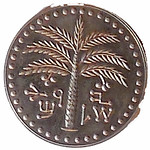 William M.
Rosenblum LLC of Littleton, Colorado will be offering “The Philadelphia Collection” in two or three different auctions with the first auction
scheduled for December 4, 2014. The collection consists of major rarities of Israeli, Palestine, Egyptian, WWII material and other documents
collected by a Philadelphia businessman and collector for more than 40 years. Rosenblum believes that this the best overall collection he has ever
offered via auction in his 44 years as a professional numismatist.
William M.
Rosenblum LLC of Littleton, Colorado will be offering “The Philadelphia Collection” in two or three different auctions with the first auction
scheduled for December 4, 2014. The collection consists of major rarities of Israeli, Palestine, Egyptian, WWII material and other documents
collected by a Philadelphia businessman and collector for more than 40 years. Rosenblum believes that this the best overall collection he has ever
offered via auction in his 44 years as a professional numismatist.
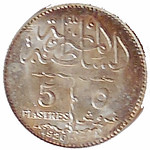 “Mr. Philadelphia” was
a true collector and received as much joy in assembling his large collection of early small-change tokens as he did when buying the famed 1927
Palestine Double Proof Set”. Rosenblum first sold him coins in 1973 and continued to sell him coins, paper money, tokens and medals until late 2011.
If it was not for his early untimely passing Mr. Philadelphia would still be adding material to his collection.
“Mr. Philadelphia” was
a true collector and received as much joy in assembling his large collection of early small-change tokens as he did when buying the famed 1927
Palestine Double Proof Set”. Rosenblum first sold him coins in 1973 and continued to sell him coins, paper money, tokens and medals until late 2011.
If it was not for his early untimely passing Mr. Philadelphia would still be adding material to his collection.
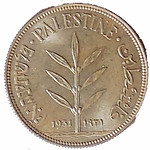 Among the many, many
highlights of the sale is the 1927 Palestine Double Proof Set in original case. The set has an impressive pedigree as it was part of the famed Sidney
Olson collection sold by NASCA in August of 1978. Rosenblum purchased the set for Mr. Philadelphia at the sale and his notes that he wrote in his
copy of the catalog are still true today. “Nice!”. Virtually all of the regular Palestine coins from the collection are mint state including one of
the nicest 100 Mil 1931 coins Rosenblum has seen in years. Other pre-State of Israel Holy Land metallic items including a wide array of 19th century
tokens, choice Ottoman and British Protectorate coins of Egyptian and a number of Palestine Mandate error coins including accompanied by a letter
from the Royal Mint.
Among the many, many
highlights of the sale is the 1927 Palestine Double Proof Set in original case. The set has an impressive pedigree as it was part of the famed Sidney
Olson collection sold by NASCA in August of 1978. Rosenblum purchased the set for Mr. Philadelphia at the sale and his notes that he wrote in his
copy of the catalog are still true today. “Nice!”. Virtually all of the regular Palestine coins from the collection are mint state including one of
the nicest 100 Mil 1931 coins Rosenblum has seen in years. Other pre-State of Israel Holy Land metallic items including a wide array of 19th century
tokens, choice Ottoman and British Protectorate coins of Egyptian and a number of Palestine Mandate error coins including accompanied by a letter
from the Royal Mint.
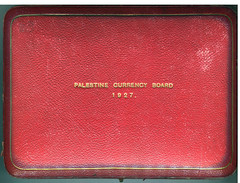

Palestine Currency Board notes in high ground abound in this collection including high grade examples of 500 Mils, 1, 5 and 10 Pound notes. Also being offered is a 5 Pound 1927 color trial note in blue not the issued orange, an uncolored 5 Pound Proof and a set of 6 Thomas de La Rue & Company specimens from their archives which include all 6 denominations with 000000 serial numbers, 4 of the notes including the 50 Pound note are dated 1927 while the legendary 100 Pound note is in green.
Among the colorful Egyptian notes being offered is a 50 Piastres note of 1918 in very high grade with a sphinx at left, a lovely uniface 50 Pound Proof depicting a caravan of camels with tombs in the background, a large and high grade 100 Pound note featuring the citadel at Cairo, a mosque and a sail boat and an incredibly choice, bright and original 5 Piastres Currency note of 1917.


Israeli coins, paper and medals for the crux of the collection and include the famous provisional issues of 1948, the rare and important inverted signature of the 100 Pruta Neeman-Eshkol fractional of 1952 and perhaps the most important and inclusive offering ever of Israel specimens, trials, proofs, progress notes and errors. One of the most intriguing lots is a group of 5 early Israeli fractional notes all with the exact same low serial number. Occasionally 2 notes with the same serial number are seen and Rosenblum has once seen 3 notes with the same number offered. He has never seen five fractional with the same serial number ever. And the set was sold by Rosenblum’s father to “Mr. Philadelphia” almost 30 years ago.
The coins and medals in this section are equally as rare and attractive. Included are numerous patterns, specimens, errors and other rarities. The collection consists of 4 different 1960 Eight-grain 1 Agora patterns, off-metal issues of coins and medals, some patterns that Rosenblum believes may be unique, others that less than 5 are known and numerous other seldom seen coins and medals including the very rare Berne Die issue of the 1971 Let My People Go 10 Lirot commemorative coin.
“Mr. Philadelphia” also collected tokens and paper issues of concentration camps, ghettos, displaced persons camps, transit camps and other issues associated with World War II and later. Among the seldom seen items being offered in this section are lead patterns from the Lodz Ghetto, two different issues of Cyprus Canteen chits, a note from Gross-Rosen and many other very rare items. Also in the collection is an “error or test” 50 Mark Lodz Ghetto which was printed on a note with an extra wide margin and without a serial number. Rosenblum first offered this note for sale in the November 1982 NICE III sale, later purchased it again and sold it a subsequent auction prior to 1995 and is now offering via auction for the 3rd time. It is the plate note in Silent Witnesses: Civilian Camp Money of World War II by the father and daughter team of Ray and Steve Feller.
The sales will also contain perhaps the largest and most varied offering of “Kollel” notes ever assembled. “Kollel” notes are basically promissory notes issued to support students studying in the Holy Land during the last years of the Ottoman Empire. The notes were usually backed my either communities in Europe or notables living in the Holy Land. A few other areas that are especially strong in the collection are emergency small change tokens used in both the British Palestine Mandate as well as the young state of Israel from the early 1940’s through the early 1950’s, stock certificates and other large financial instruments used in the Holy Land during Otttoman and British rule and a number of letters, documents and signed photographs.
Rosenblum has been issuing price lists and conducting auctions since 1971 and continues to be a leader in the field of Jewish and Holy Land related numismatic material. His sales do not have a buyer’s fee. The printed catalogs were mailed this past week, and are available in both the printed version and an on-line version.
Virtually all lots will be available for viewing at Rosenblum’s table at the November 20-22 National Currency and Coin Convention (formerly the PCDA show) at the Crowne Plaza Chicago O'Hare in Rosemont, IL and at the November 29th Aurora, Colorado Show being held at the Radisson Hotel.
For more information contact Bill Rosenblum at Bill@Rosenblumcoins.com or via phone at 720-981-0785. Other details will be announced from time to time at www.rosenblumcoins.com. The firm can also be reached by mail at P. O. Box 785, Littleton, CO 80160-0785. The printed version of the catalog will be sent gratis to Rosenblum’s regular clients, others can reserve the catalog (with prices realized to follow after the sale) for $15 for US delivery or $25 everywhere else.
COMMEMORATIVE MEDAL SELECTIONS FROM BALDWIN'S
Exposition Universelle, Ghent, 1913
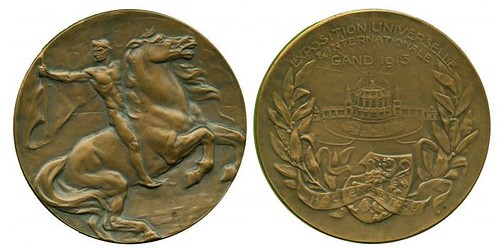
Belgium, Exposition Universelle & Internationale, Ghent 1913, Bronze Medal by Carl Decock, nude flag-bearer on horseback, the flag inscribed SPORTS, rev view of the exhibition buildings within wreath, 55mm. Extremely fine.
To view the complete item description, see:
www.baldwin.co.uk/ghent-1913.html
Armand Hubert, 1913
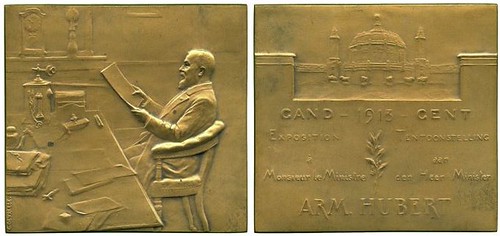
Belgium, Ghent, 1913, Armand Hubert, minister of works and industry, square Bronze Medal by G. Devreese, Hubert in his office, rev architectural view, 66x66mm. Extremely fine.
To view the complete item description, see:
www.baldwin.co.uk/armand-hubert-1913.html
Death of William Pitt, 1806
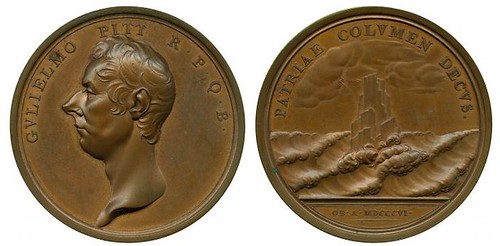
George III, Death of William Pitt, 1806, Bronze Medal by T Webb, bust left, GVLIELMO PITT R . P . Q . B ., rev a rock buffeted by stormy waves, PATRIAE COLVMEN DECVS., 53mm, in original case of issue (BHM 610; Eimer 975). About as struck.
To view the complete item description, see:
www.baldwin.co.uk/death-of-william-pitt-1806.html
International Food Industry Exhibition, 1893
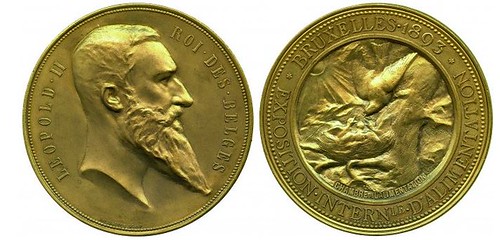
Belgium, International Food Industry Exhibition, Brussels, 1893, Gilt-bronze Medal by Jules Baetes for the Ministry of Food, bust of Leopold II right, rev a bird’s nest with mother feeding young, 60mm. Extremely fine.
To view the complete item description, see:
www.baldwin.co.uk/international-food-industry-exhibition-1893.html
THE BOOK BAZARRE
NUMMIS NOVA NUMISMATIC DIARY: NOVEMBER 16, 2014
An Anglo-American Cake

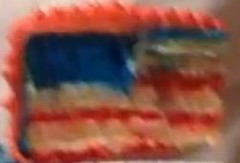
Eric's Overview
Eric Schena writes:
About 12 of us were at the dinner and since the theme was military service and numismatics, I brought a selection of World War I local service medals from the area, including ones issued by the State of Delaware (named), City of Norfolk (named), City of Harrisonburg/Rockingham County, City of Roanoke, City of Winchester/Frederick County, Washington DC (named to an officer in QMRC), and a Mexican Border Service Medal to a member of the 5th Maryland Infantry (National Guard).
Mike Packard brought an enormous photo book of World War I personalities that was fascinating to flip through, and Aaron Packard had a great selection of mostly Civil War storecards to show. Lenny Goldberg brought a few military "good fors" and Dave as always had some outstanding medals he picked up at Baltimore to pass around (including one Julian Leidman teased everyone as being a bowling piece).
Julian, Wayne Herndon, Gene Brandenberg, Steve Nishop, Chris Neusil, and Jon Radel all joined in the fun as always - had some really interesting discussions about all aspects of numismatics. To me, these dinners typify the best of our chosen field - camaraderie, great stories, and an amazing talent pool. It is always a highlight of my numismatic calendar.
Query: Two Unusual 1876 Centennial Items
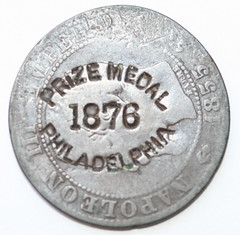
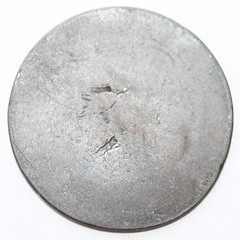
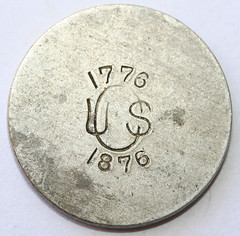

Dave Schenkman writes:
At the dinner Tuesday I passed around two unusual 1876 Centennial items I purchased at the recent Baltimore show. The “Prize Medal” is counterstamped on an 1855 French 5 centimes. The other one was struck with incuse lettering on a 21.5mm nickel planchet. I mentioned them to Ron Abler, who recently published an on-line catalog of Centennial medals, but neither rang a bell with him. I haven’t attempted to research them yet, but do recall that a couple of tokens from the Rock Island (Illinois) Arsenal with crossed cannons and bomb design are pictured in Paul Cunningham’s catalog of military tokens.
Trials and Triumphs of Labor
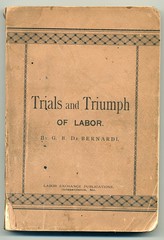
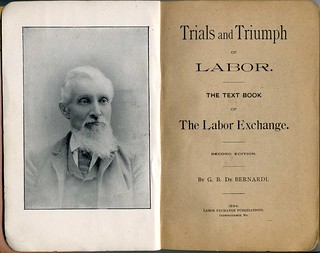
Eric Schena writes:
I didn't bring it because I knew Wayne Homren would not be there, but I recently purchased a copy of the Trials and Triumph of Labor book by Labor Exchange movement founder G. B. De Bernardi . It has a photo of De Bernardi himself. Wayne introduced me to Labor Exchange currency at one of our meetings, and I've become an active collector.
Civil War Tokens
Aaron Packard writes:
Tuesday’s theme was based on Veteran’s Day. Thus, I brought a few Civil War Patriotics, as well as storecards with patriotic reverses.
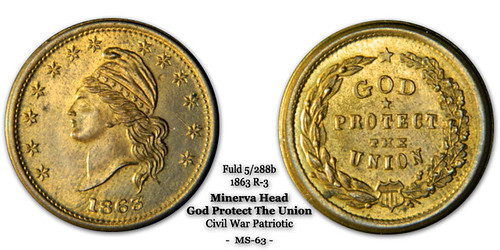
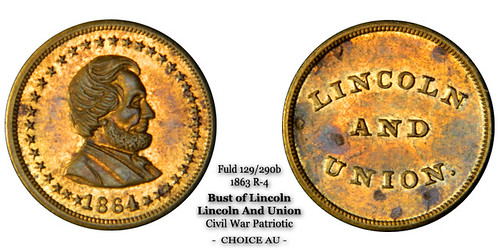
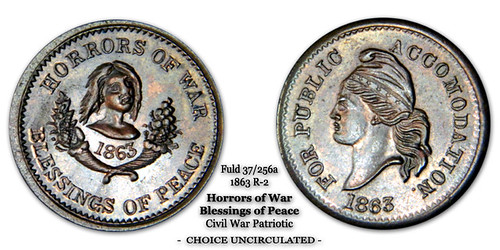
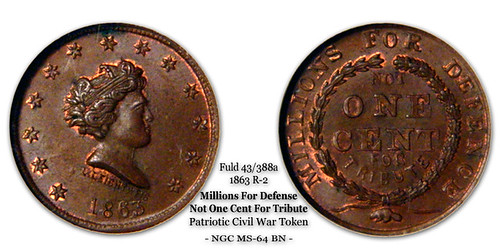
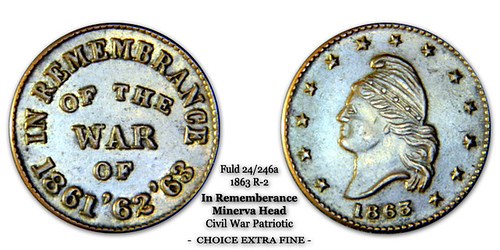
HOW TO MAKE YOUR OWN COINS, PART 2
You won’t find Purple Shaftieuland on a map – but they have “coins”!
If you’ve always wanted to issue your own coins, but don’t want to go the traditional route, then you could always proclaim your own nation.
Such a nation doesn’t require land upon which to dwell, and may only occupy space in your imagination.
In so doing, you would be following a tradition of the last half-century,when “coins” for places like Bermania, Buck Island, the Grandy Duchy of Westarctica, the Ultimate State of TÆDIVM, and many others, have been issued.
Perhaps the most biting of these issues are the “coins” for the nation of “Purple Shaftieuland.”
In 1970, coin dealer Bob Kolasa created the coin series as a revolt against the flourishing of noncirculating legal tender coins from barely identifiable places, aimed specifically at collectors (a lament that might ring true even today).
The “coins” also poked fun at the practice of U.S. government foreign aid, and used stereotypical humor to make the point. The politically incorrect brochure accompanying the pieces also features very thinly veiled comments about some of the companies creating the market for international Proof sets in the late 1960s.
According to coin dealer Joel Anderson (who provided the brochure to Coin World), Purple Shaftieuland had five denominations: 1 nudge, 1 twist, and quarter-, half- and full-shaft pieces. The coins were issued in two versions, “brilliant brass” and “unanodized aluminum.”
According to the brochure, the exchange value is fixed: 100 nudges equal 10 twists, which equals one full shaft, which of course equals “nothing U.S.”
As the brochure also noted, the “coins” had staying power as an investment.
“The beauty of these, as with many foreign proof sets is that they never go down in true value. They can’t go down because they’re worthless to begin with.”
To read the complete article, see:
PROCLAIM YOUR OWN NATION AND ISSUE YOUR OWN COINAGE
(www.coinworld.com/voices/jeff-starck/2014/11/proclaim_your_ownna.html)
To read the earlier E-Sylum article, see:
HOW TO MAKE YOUR OWN COINS (www.coinbooks.org/esylum_v17n45a37.html)

ISIS TO ISSUE ITS OWN COINAGE?
 ISIS wants to
introduce its own currency and plans to bring back solid gold and silver dinar coins, it has emerged.
ISIS wants to
introduce its own currency and plans to bring back solid gold and silver dinar coins, it has emerged.
The Middle East terror group apparently wants to introduce its own Islamic currency as part of its attempts to solidify its makeshift caliphate.
Militants are said to want to bring back the original dinar, which is an ancient currency from early Islam, and religious figures in Mosul and Iraq’s Nineveh province have apparently announced its return in mosques.
The currency known as the dinar, which once consisted purely of gold and silver coins, is today used by a variety of countries, but the coins are created from different materials to the originals.
However, the jihadi group is understood to be planning to return to the original gold and silver coins, which were first introduced during the Caliphate of Uthman in 634 CE.
The original Islamic dinar was a gold coin which was the weight of gold equivalent to 4.3 grams. Its silver counterpart, known as the Islamic dirham, was a silver coin equal in weight to 3 grams of silver.
Both were round in shape and one side of the coin was typically stamped with an Islamic message, while the other side featured the date of minting and the country’s ruler.
While ISIS has yet to confirm the introduction of its currency, social media is awash with claims that leading religious figures announced the plans during recent prayers in Mosul and Nineveh province.
It is believed the terror outfit wants to use the independent currency in areas it controls as part of its war on the West.
To read the complete article, see:
Now ISIS wants to introduce its own currency: Plans to bring back solid gold and silver dinar coins announced in Iraqi mosques
(www.dailymail.co.uk/news/article-2829097/Now-ISIS-wants-introduce-currency-Plans-bring-solid-gold-silver-dinar-coins-announced-Iraqi-mosques.html)
Ben writes:
This is really interesting. As a collector, I wonder about the ethics of purchasing or owning coins minted by an oppressive organization and largely funded by ransoms and extortion. On the other hand, we collect coins from plenty of oppressive and violent rulers.
ISIS is planning to mint its own currency in gold, silver and copper, the group said Thursday.
Its aim is to stay away from the "tyrant's financial system," ISIS said in a statement. It said it would issue another statement to explain the new currency's exchange rate, and where it can be found.
The currency will include seven coins: two gold, three silver and two copper. The move is "purely dedicated to God" and will remove Muslims from the "global economic system that is based on satanic usury," ISIS said.
The terror group, which calls itself the Islamic State, has seized large swaths of territory in Iraq and Syria.
It seeks to establish an Islamic caliphate in the region.
To read the complete article (and watch a video), see:
ISIS announces new currency
(www.cnn.com/2014/11/13/world/meast/isis-currency/index.html?hpt=hp_c2)

A website affiliated with the militant group said late on Thursday that its leader, Abu Bakr Baghdadi, has instructed his followers to start minting the coins to "change the tyrannical monetary system" modelled on Western economies that "enslaved Muslims."
The posting says the order was approved by the group's Shura Council, an advisory board.
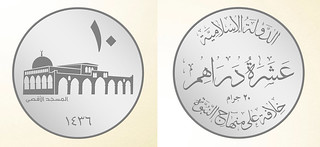 Sketches of the coins appear in the statement released by Islamic
State's Beit al Mal, or treasury, that was posted on websites used by jihadist movements. Depicted on the coins are symbols of Islam. On one of
the silver coins is a picture of the Al-Aqsa mosque, which is situated on Temple Mount/Haram al-Sharif in Jerusalem.
Sketches of the coins appear in the statement released by Islamic
State's Beit al Mal, or treasury, that was posted on websites used by jihadist movements. Depicted on the coins are symbols of Islam. On one of
the silver coins is a picture of the Al-Aqsa mosque, which is situated on Temple Mount/Haram al-Sharif in Jerusalem.
Issuing the coins is part of Islamic State's efforts to achieve statehood, Mohsin Khan, a senior fellow at the Atlantic Council’s Rafik Hariri Center for the Middle East, told Bloomberg. “One of the attributes of a state is that it issues its own currency,” he reportedly said by phone from Washington. “That defines you as a state at least in the eyes of your own people and perhaps in the eyes of others.”
“The important thing is: where are they going to get the gold and copper [used to produce the coins]?" Steven H. Hanke, professor of applied economics at Johns Hopkins University, told the Financial Times. "ISIS will have to confiscate more property through theft and the spoils of war."
To read the complete article, see:
ISIS to mint new coins to fight West's 'tyrannical
monetary system' (www.haaretz.com/mobile/1.626459?v=D97C73A5B4B3546B43B6D5D59B14493D)
On one of the gold coins with be a symbol of seven wheat stalks and on the other a world map.
The silver coin had three different denominations: one symbolised with a spear and shield, another with a white minaret of Damascus and a third with the al-Aqsa mosque - one of the holiest sites in Islam. For the copper currency, one coin has a crescent while another more valuable coin has a palm tree.
To read the complete article, see:
Islamic State announces its
own currency (www.telegraph.co.uk/news/worldnews/islamic-state/11230324/Islamic-State-announces-its-own-currency.html)
Can the group really create a viable currency?
Many money historians and other experts said no, describing the announcement as a propaganda exercise, meant largely to reinforce the Islamic State’s self-anointed legitimacy.
They said practical problems could doom the currency, notably its stigma elsewhere, severely limiting its use for money’s basic purposes of buying and selling other goods and services.
“What central bank is going to accept an ISIS coin?” said David L. Phillips, a former adviser at the United Nations and the State Department, now at Columbia University’s Institute for the Study of Human Rights.
“It’s like blood diamonds,” he said. “No credible financial institution is going to take this.”
“Of course this is nonsensical,” said Steve H. Hanke, a currency expert at Johns Hopkins University. The purchasing power of gold, he said, “is determined in the world market, and has nothing to do with ISIL.”
Some economists said there could be something to the Islamic State’s aspiration to use gold for money, seeing it as a potential new venue for smuggling and thievery.
They noted that since charging interest is forbidden under strict interpretations of Islamic law, gold as a non-interest-bearing investment could be an ideal way for more strict Muslims to transact business and amass wealth.
To read the complete article, see:
Islamic State Says It Plans
to Issue Its Own Currency (www.nytimes.com/2014/11/15/world/middleeast/islamic-state-says-it-plans-to-issue-its-own-currency-.html)
The whole discussion is a bit daft when you consider that ISIS, despite its aspirations and proclamations, is not now and will likely never be a state and endures daily bombing campaigns and armed pushback from all directions.
To further illustrate how much of a non-story it is, we present five reasons why ISIS is not manufacturing its own gold and silver coinage, nevermind whether such a move would topple the economic superpowers of the West or not.
1) ISIS lacks the means of production
2) Coin-minting infrastructure is an obvious target
3) ISIS isn’t rich, despite what the media suggests
4) The coins would likely be melted… immediately
5) The “story” is little more than ISIS trolling the West through social media
The most effective campaigns use the media to communicate their message to the general public.
What ISIS has done by posting a few tweets about their desire to strike gold and silver coins is a good example of such media manipulation. Let’s be clear, there can be no vetting of this story. ISIS is not a country. It has no embassies or consulates, no treasury department, no sources of bullion nor production facilities. They have sent no one forward to officially announce the claim, and have fielded no reporter’s questions.
Yet it’s somehow “newsworthy”, spreading across the airwaves as fast as any rumor about Ebola.
In the immortal words of the Internet Generation: “U MAD BRO?”
Maybe ISIS will prove us wrong and establish its own mint. Maybe it will source gold and silver ingots by the ton. Maybe it will hire a staff of skilled engravers, die cutters, and press operators and find a way to distribute it all. Maybe some kind of money will actually circulate. Saying it’s impossible isn’t the point.
But if that day comes, then have at it, media. You’ll have a really interesting coin story for a slow news day.
To read the complete article, see:
Why the National Media Has the ISIS Gold
and Silver Coin Story Wrong (www.coinweek.com/recent-articles-video/national-media-isis-gold-silver-coin-story-wrong/)
QATARI COIN COLLECTOR SHEIKH AL-THANI DIED
Sheikh Saud bin Mohammed Al-Thani of Qatar, at one time the biggest art collector in the world, died at his home in London on Sunday, aged 48. The news was announced at a museums conference in Doha, earlier today, 10 November. The cause of his death has not been announced, although it is believed to have been from natural causes. Sheikh Al-Thani, a distant cousin of the current Emir, served as Qatar’s minister of culture from 1997 until 2005 and oversaw an ambitious museum building programme for the oil and gas-rich Gulf state.
He also built a massive collections of antiquities, photography, Chinese and Islamic art (many of his purchases in this field are now on display in the Museum of Islamic Art in Doha). He also collected furniture, vintage cars, natural history, jewellery, even bicycles, but it was sometimes unclear if the collections he had assembled belonged to him or to Qatar. In 2005 he was dismissed and placed briefly under house arrest while some of his purchases were investigated. He returned to the market a short time later, buying for his own collections in various fields including Chinese art and coins.
In 2012, a High Court judge in London froze $15m worth of his assets as part of a dispute over unpaid bills to auction houses. The numismatic auctioneers Baldwin’s, Dmitry Markov and M&M Numismatics, accused him of defaulting on bids for items from the Prospero Collection, a cache of Greek coins.
To read the complete article, see:
One of the world’s top
collectors Sheikh Al-Thani dies suddenly, aged 48
(www.theartnewspaper.com/articles/One-of-the-worlds-top-collectors-Sheikh-AlThani-dies-suddenly-aged--/36262)
Sheikh Saud bin Mohammed Al-Thani, the former minister of culture and heritage in Qatar, who spent more than $1bn (£630m) of the oil rich country's money on art, has died aged 48.
Details of his death have not been announced.
 His huge
collection is spread across five existing and planned museums: the Museum of Islamic Art, the National Library, the Natural History Museum, a
Photography Museum, and a museum for traditional textiles and clothing.
His huge
collection is spread across five existing and planned museums: the Museum of Islamic Art, the National Library, the Natural History Museum, a
Photography Museum, and a museum for traditional textiles and clothing.
Sheikh Al-Thani wasn't a big deal in art buying circles, he was massive. He alone was responsible for putting several degrees of heat into what is today's scorching hot art market. When he was in town - so the rumour goes - art dealers and auction houses would dust down their best stuff, add a nought or two, and await his visit.
What made Sheikh Al-Thani stand out wasn't just the vast sums of money he was willing to spend, but the fact that he bought across the categories, from fast cars to fine art.
When he wanted a certain object, he would simply keep on bidding until it was his. There are stories of items valued at a few thousand pounds that would suddenly be nudging seven figures because the Sheikh and an under-bidder were locked in an act of brinkmanship.
The upshot of his passionate, eclectic, 20-year campaign - undertaken with a keen eye and an aesthete's sensibilities - was the creation of a world-class collection, some of which will help fill Qatar's new museums.
His life was not without controversy. He famously fell out with his cousins, the Qatari royal family, who had him put under house arrest for a short while. And, in 2012, the High Court in London froze some of his assets due to a legal wrangle with auction houses over disputed invoices.
To read the complete article, see:
Qatari art collector Sheikh Saud bin Mohammed Al-Thani dies
(www.bbc.com/news/entertainment-arts-30001716)
LIBERTY DOLLAR CREATOR TO BE SENTENCED
 Liberty Dollar creator and self proclaimed “monetary architect” Bernard von NotHaus, who was found guilty in US federal court in North Carolina on
March 2011 of Counterfeiting and Fraud, is scheduled to appear on December 2nd before U.S. District Court Judge Richard L. Voorhees. The now 70 year
old von NotHaus has been awaiting sentencing for over 3 1/2 years.
Liberty Dollar creator and self proclaimed “monetary architect” Bernard von NotHaus, who was found guilty in US federal court in North Carolina on
March 2011 of Counterfeiting and Fraud, is scheduled to appear on December 2nd before U.S. District Court Judge Richard L. Voorhees. The now 70 year
old von NotHaus has been awaiting sentencing for over 3 1/2 years.
The Justice Department asserted that von NotHaus was placing gold, and silver coins, along with precious metals currency into circulation with the purpose of mixing them “into the current money of the United States.”. In short, the government accused von NotHaus of counterfeiting.
Mr. von NotHaus developed the Liberty Dollar in 1998. as an “inflation-proof” alternative currency to the U.S. Dollar, which he has claimed has devalued since the Federal Reserve was established in 1913. The silver and gold “coins” were produced by the Sunshine mint in Idaho on behalf of the Evansville, Illinois-based Liberty Services, which also issued paper notes which the group says are backed by silver reserves.
In November of 2007, federal officials raided the group’s headquarters, located in a strip mall and seized all documents and the gold and silver that backed up the paper certificates and digital currency being distributed thought Liberty Services website. In addition all coins, bullion and even the dies used to strike the Liberty dollar coins held in the vault at the Sunshine Mint has also been confiscated.
When asked about the government’s motive for accusing him of terrorism, von NotHaus replyed, “This is the United States government. It’s got all the guns, all the surveillance, all the tanks, it has nuclear weapons, and it’s worried about some ex-surfer guy making his own money? Give me a break!”
To read the complete article, see:
Bernard von NotHaus, “Architect” of the
Liberty Dollar to be Sentenced (www.coinweek.com/people-in-the-news/bernard-von-nothaus-architect-liberty-dollar-sentenced/)
THE BOOK BAZARRE
RUSSIAN EBAY SELLER OF COIN COPIES
Philip Mernick of London located another seller of potentially deceptive coin counterfeits. He writes:
This Russian seller (elmash2014) is offering an interesting range of reproductions which I don’t recall seeing before.
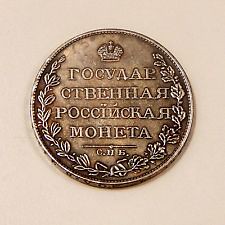

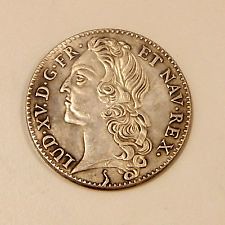
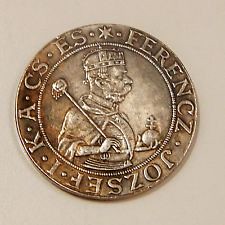
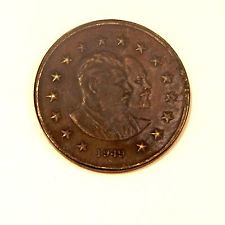
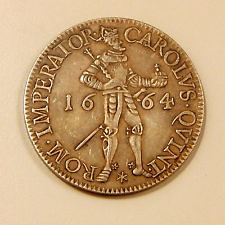
To view the seller's listings, see:
www.ebay.co.uk/sch/elmash2014/m.html?item=291297169061&hash=item43d2aa0ea5&pt
=LH_DefaultDomain_0&rt=nc&_trksid=p2047675.l2562
To read the earlier E-Sylum article, see:
CHINESE GOLD-PLATED TUNGSTEN BULLION COIN COPIES
(www.coinbooks.org/esylum_v17n46a16.html)
2015 COIN OF THE YEAR FIRST ROUND RESULTS
Three Austrian coins came out on top during the first round of World Coin News' Coin of the Year Award voting by an international panel of judges that concluded.
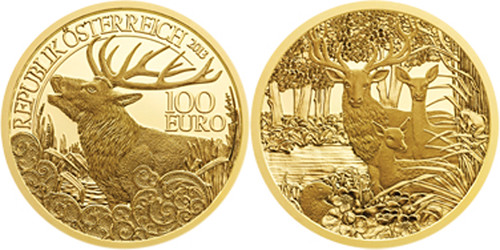
A 100-euro gold coin, KM-3225, issued in the Austrian Wildlife series and depicting a Red Deer was tops in the Most Artistic Coin category.
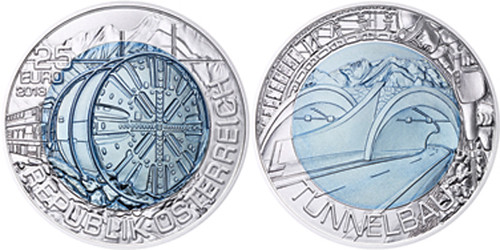
Triumphing in the Best Bi-Metallic Coin category is a Tunneling themed 25-euro silver and niobium coin, KM-321.
The third category winner named Best Gold Coin is a 50-euro coin issued in the Klimt and His Women series called The Expectation, KM-3218.
No other country won more than one of the 10 COTY categories.
The Most Historically Significant category winner was The Netherlands 5-euro silver coin marking the 1713 Treaty of Utrecht that ended the War of the Spanish Succession, KM-326.
Winning the Best Contemporary Event category was a copper-nickel ruble, KM-436, issued by Belarus to commemorate the 90th anniversary of the founding of BPS-Sberbank. This category honors historically important events that occurred less than 100 years ago.
Judges bestowed Best Silver Coin honors to Latvia's 1 lats coin marking the 200th anniversary of the birth of composer Richard Wagner, KM-140.
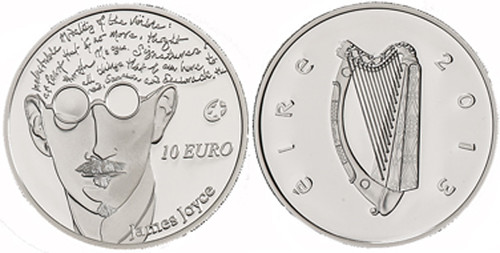
Best Crown winner was Ireland's silver 10 euro commemorating author James Joyce, KM-80.2. Crowns are coins with a diameter of 37 millimeters to 45 mm.

The United States Mount Rushmore quarter beat out the competition in the Best Circulating Coin category. The copper-nickel piece is KM-546 and is part of the America the Beautiful series of 25-cent pieces.
A coin showing a howling wolf, which is actually a cutout, was called the Most Innovative Coin by the judges. Issued by Mongolia, the coin is gilded silver and has a 500-tugrik denomination, KM-328.
Canada topped voting in the Most Inspirational Coin category with a silver $3 showing Grandfather and Grandson Fishing, KM-1485.
Images and descriptions for each of the winning coins can be found here.
Judges will now select the Coin of the Year from this field of 10 category winners. All pieces are dated 2013.
Judging will conclude Dec. 6 and the results will be published in the January issue of World Coin News.
To read the complete article, see:
Austria dominates first round of Coin of the Year voting
(www.numismaster.com/ta/numis/Article.jsp?ArticleId=27984)
To read the earlier E-Sylum article, see:
2015 COIN OF THE YEAR NOMINEES (www.coinbooks.org/esylum_v17n45a40.html)
ROSENBLUM AUCTION ACTION

Our Fall 2014 auction is our best in over 44 years of issuing auction catalogs and price-lists. One of the finest collections of Israel and Palestine coins and paper along with other fine consignments. Please click on the link to the auction here .
Or call or email us. A limited number of printed paper catalogs are also available which we will make available to any E-Sylum reader gratis as long as our supply lasts. Most lots will be available for viewing at our table at the Chicago Currency and Coin Convention in Rosemont, IL November 20-22 (we won't be there on Sunday) and the Aurora, Colorado show November 29th.
AUSTRIAN BANKNOTE BRIBERY SCANDAL
One day in December 2005, a few hours before dawn, employees of the Austrian central bank, dressed in blue overalls, began stacking about 30 million bank notes onto wooden pallets. They loaded the manat bills, the currency of Azerbaijan, into 38-ton trucks, according to people familiar with the shipment. Escorted by police in unmarked BMWs, the convoy rumbled past Vienna’s centuries-old churches and Habsburg palaces, crossed the Slovakian border and arrived at Bratislava Airport. There, the shrink-wrapped pallets were loaded onto a plane destined for Baku, Azerbaijan’s capital on the shores of the Caspian Sea.
It looked like any other transaction in the international money-printing market, where bills are bought and sold amid tight security. But Austrian prosecutors say the sale was part of a corrupt bargain between officials at the Austrian central bank and their Azerbaijani counterparts.
Prosecutors put nine people on trial earlier this year, with charges including bribery and money laundering. The defendants included the co-chief executives of Oesterreichische Banknoten-und Sicherheitsdruck, or OeBS, the printing subsidiary of Oesterreichische Nationalbank, Austria’s central bank.
Austrian prosecutors said the central-bank employees jacked up the price of the currency so the surplus could be used for bribes. A total of $18 million was paid through offshore accounts to officials at Azerbaijan’s and, later, Syria’s central banks to win printing contracts, prosecutors say.
The Austrian case affords a rare glimpse inside an industry shrouded in secrecy and mystique. Currency scandals have blown up periodically since the Lydians first minted coins in about 650 B.C. In 1278, an Englishman named Philip de Cambio was convicted of adding more than the legal amount of copper to pound coins; he was hanged and dismembered.
In the 1920s, a Portuguese scam artist, Artur Virgilio Alves Reis, persuaded a British currency-printing firm that he was an envoy from Banco de Portugal, and the company printed and delivered to him several million Portuguese escudos before the fraud was discovered, according to “Moneymakers: The Secret World of Banknote Printing,” by German journalist Klaus W. Bender.
Today, the business of printing bank notes is a large and highly technical enterprise. Government agencies and their private contractors produce 165,000 tons of currency annually, and the bills must be adorned with holograms, special inks and raised print so they are as difficult as possible to counterfeit.
The job is beyond the capacity of many countries, so about half of the world’s bank notes are produced by private companies. Three dominate the market, accounting for about 60 percent of sales: Basingstoke, England-based De La Rue, the company that prints the British pound; Germany’s Giesecke & Devrient; and France’s Arjowiggins, according to a 2011 report by the California-based consulting firm Impacts.Ca. The industry was worth about $1.3 billion in 2011.
To read the complete article, see:
Austrian currency scandal shines light on the enigmatic industry of money printing
(www.washingtonpost.com/business/austrian-currency-scandal-shines-light-on-the-enigmatic-industry-of-money-printing/2014/11/14/aabef40c-69f0-11e4-a31c-77759fc1eacc_story.html?tid=hpModule_79c38dfc-8691-11e2-9d71-f0feafdd1394)
BEAUTIFULLY DEFACED ONE DOLLAR BILLS
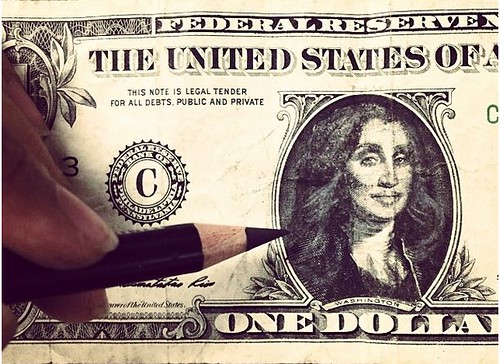
Cher
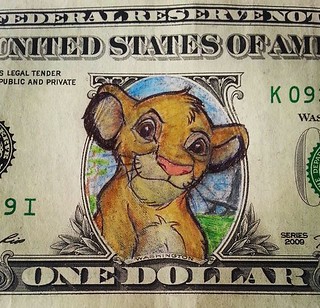
Georgeba

The Geoker
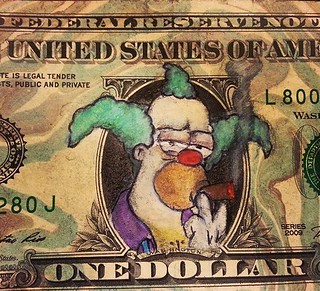
Krusty the President
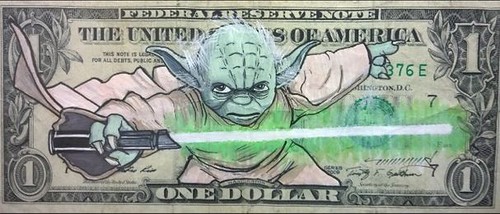
Geyoda
To read the complete article, see:
27 Beautifully Defaced One Dollar Bills
(www.buzzfeed.com/christianzamora/beautifully-defaced-one-dollar-bills)
TOM'S TOOTH TOKENS
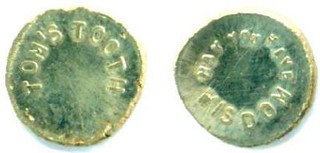

As noted in the last issue, I had to go to Seward to be a presenter, along with Kaye Dethridge and Irene Shuler, at the Alaska Historical Society’s annual meeting. The high point of the trip was a late breakfast with Kaye and Irene, and also Tom Dalrymple.
During our meal, Tom made the comment that he had had an extraction the previous day, and slid a small plastic box across the table to me. It was a cute little box, with a tooth fairy on the top. Inside was a gold crown from one of Tom’s wisdom teeth. Some might say that this was not an appropriate meal time topic, but it was only the crown, no tooth. As he slid it across the table, he said “Make something for me.”
Tom is an assistant professor of accounting at Kenai Peninsula College. After spending three days with him at the coin show at the Kenai Peninsula Fair in Ninilchik in August, I came to appreciate his sense of humor. I am sure he found this greatly entertaining.
Driving to Anchorage to catch the flight back to Fairbanks, I was thinking about the tooth. About the only thing that Tom could even think I could make was a token. So, what kind of token? Let’s see. It was a wisdom tooth, so “WISDOM” something. “MAY YOU HAVE WISDOM.” The other side would simply be TOM’S TOOTH.
I figured this would be easy. It was not. When melted into a button, because of the alloy of dental gold, the tooth had a very dark top surface. The lighter components go to the surface and oxidize. Various means were tried to remove this discoloration. Finally an acid bath was successful.
Once the dark film was removed, I could start forming the button into a planchet using the screw press. After one or two presses, it must be annealed again to prevent cracks from forming around the edge.
And the dark film was back, which means back into the acid. After several rounds of flattening, annealing and acid bathing, the button was large enough to cover the dies.
This done, I set up the dies in the screw press and gave the swing arm a good throw. I looked at the results - very faint. It was so faint, I had a hard time reseating the token in the dies. I pressed it 4, 5, 6 more times, and it was still faint.
It was once again back to several rounds of annealing, acid bathing and pressing. This procedure was followed at least four times before I gave up. It was as good as it was going to get. Besides, the dies were now bent out of shape. And so was I! This had taken four hours.
And the lesson I learned was....don’t play with dental gold. It is too hard.
I made silver tokens for Tom to go along with the gold (after all, he did pay for breakfast), and these pressed like butter!

FEATURED WEB SITE: ROWE-BARR TEXAS CURRENCY
This week's Featured Web Site is the Rowe-Barr Collection of Texas Currency at DeGolyer Library of Southern Methodist University.The Rowe-Barr Collection of Texas Currency at the DeGolyer Library is the most comprehensive in the United States, representing thousands of notes, scrip, bonds, and other financial obligations, issued in Texas between the 1820s and 1935.
John N. Rowe III and B.B. Barr are brothers-in-law, business partners, and advocates for historical preservation. Both men enjoy collecting and sharing the fruits of their collecting with others. Mr. Rowe, one of the leading numismatic dealers in the United States, started collecting bank notes as a boy. His hobby soon turned into a full-time profession. His special interest is Texas currency through the Civil War. Mr. Barr devoted much of his effort to collecting notes from the post-Civil War period. The men gave their collection to SMU in 2003, so it would be preserved and made accessible to others. This digital collection includes currency from significant historical eras, including the Republic of Texas (1836-1845), early statehood (1845-1861), the Confederacy (1861-1865), and the National Bank Era (1863-1913).
The Rowe-Barr currency collection offers an interesting avenue of access to life in Texas from the early days of its independence from Mexico through the years of the Great Depression. Issued by more than 100 counties, as well as banks, merchants, and private individuals, these notes were most often redeemable for cash, but sometimes for land or shares of stock.
Among the more famous signatures are those of Sam Houston, Mirabeau B. Lamar, David G. Burnet, Asa Brigham, Francis R. Lubbock, John Wyatt Moody, and Green DeWitt. Designs on the notes range from simple to quite elaborate and decorative.
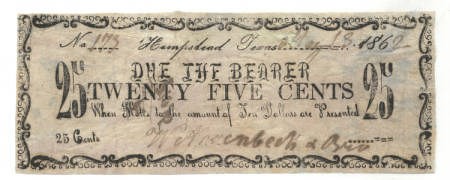
digitalcollections.smu.edu/all/cul/tbn/

